Design of Additive Manufactured Lattices with Graded Porosities for Dental Implants
VerifiedAdded on 2022/11/26
|28
|7157
|422
AI Summary
This research focuses on the designing of additive manufactured lattices with graded porosities for dental implants. It explores the impact of lattice structure and evaluated porosities in the dental implantation process, and provides a critical evaluation of the suggested process. The aim is to enhance dental implantation using additive manufacturing lattice with graded porosities.
Contribute Materials
Your contribution can guide someone’s learning journey. Share your
documents today.
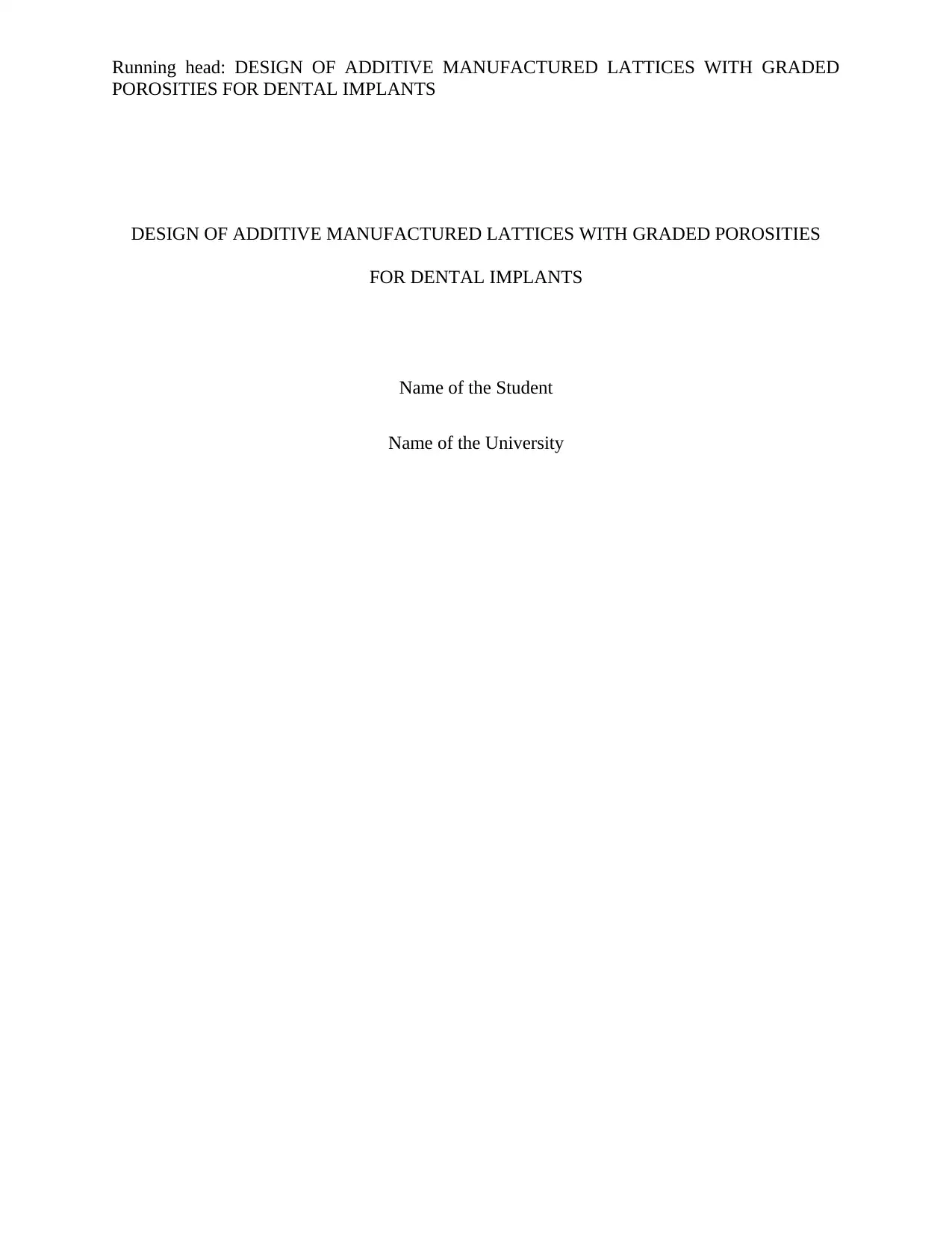
Running head: DESIGN OF ADDITIVE MANUFACTURED LATTICES WITH GRADED
POROSITIES FOR DENTAL IMPLANTS
DESIGN OF ADDITIVE MANUFACTURED LATTICES WITH GRADED POROSITIES
FOR DENTAL IMPLANTS
Name of the Student
Name of the University
POROSITIES FOR DENTAL IMPLANTS
DESIGN OF ADDITIVE MANUFACTURED LATTICES WITH GRADED POROSITIES
FOR DENTAL IMPLANTS
Name of the Student
Name of the University
Secure Best Marks with AI Grader
Need help grading? Try our AI Grader for instant feedback on your assignments.
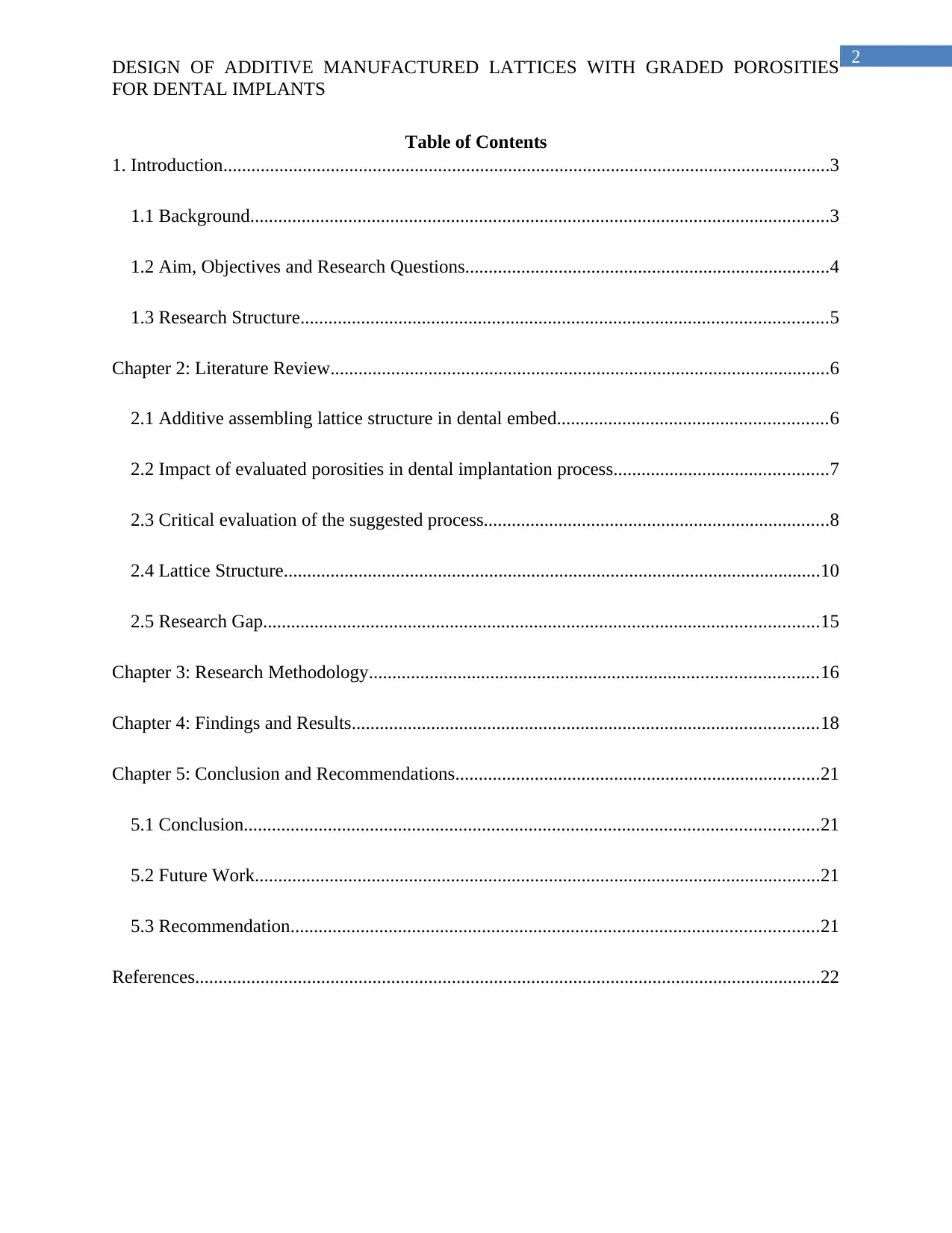
2
DESIGN OF ADDITIVE MANUFACTURED LATTICES WITH GRADED POROSITIES
FOR DENTAL IMPLANTS
Table of Contents
1. Introduction..................................................................................................................................3
1.1 Background............................................................................................................................3
1.2 Aim, Objectives and Research Questions..............................................................................4
1.3 Research Structure.................................................................................................................5
Chapter 2: Literature Review...........................................................................................................6
2.1 Additive assembling lattice structure in dental embed..........................................................6
2.2 Impact of evaluated porosities in dental implantation process..............................................7
2.3 Critical evaluation of the suggested process..........................................................................8
2.4 Lattice Structure...................................................................................................................10
2.5 Research Gap.......................................................................................................................15
Chapter 3: Research Methodology................................................................................................16
Chapter 4: Findings and Results....................................................................................................18
Chapter 5: Conclusion and Recommendations..............................................................................21
5.1 Conclusion...........................................................................................................................21
5.2 Future Work.........................................................................................................................21
5.3 Recommendation.................................................................................................................21
References......................................................................................................................................22
DESIGN OF ADDITIVE MANUFACTURED LATTICES WITH GRADED POROSITIES
FOR DENTAL IMPLANTS
Table of Contents
1. Introduction..................................................................................................................................3
1.1 Background............................................................................................................................3
1.2 Aim, Objectives and Research Questions..............................................................................4
1.3 Research Structure.................................................................................................................5
Chapter 2: Literature Review...........................................................................................................6
2.1 Additive assembling lattice structure in dental embed..........................................................6
2.2 Impact of evaluated porosities in dental implantation process..............................................7
2.3 Critical evaluation of the suggested process..........................................................................8
2.4 Lattice Structure...................................................................................................................10
2.5 Research Gap.......................................................................................................................15
Chapter 3: Research Methodology................................................................................................16
Chapter 4: Findings and Results....................................................................................................18
Chapter 5: Conclusion and Recommendations..............................................................................21
5.1 Conclusion...........................................................................................................................21
5.2 Future Work.........................................................................................................................21
5.3 Recommendation.................................................................................................................21
References......................................................................................................................................22
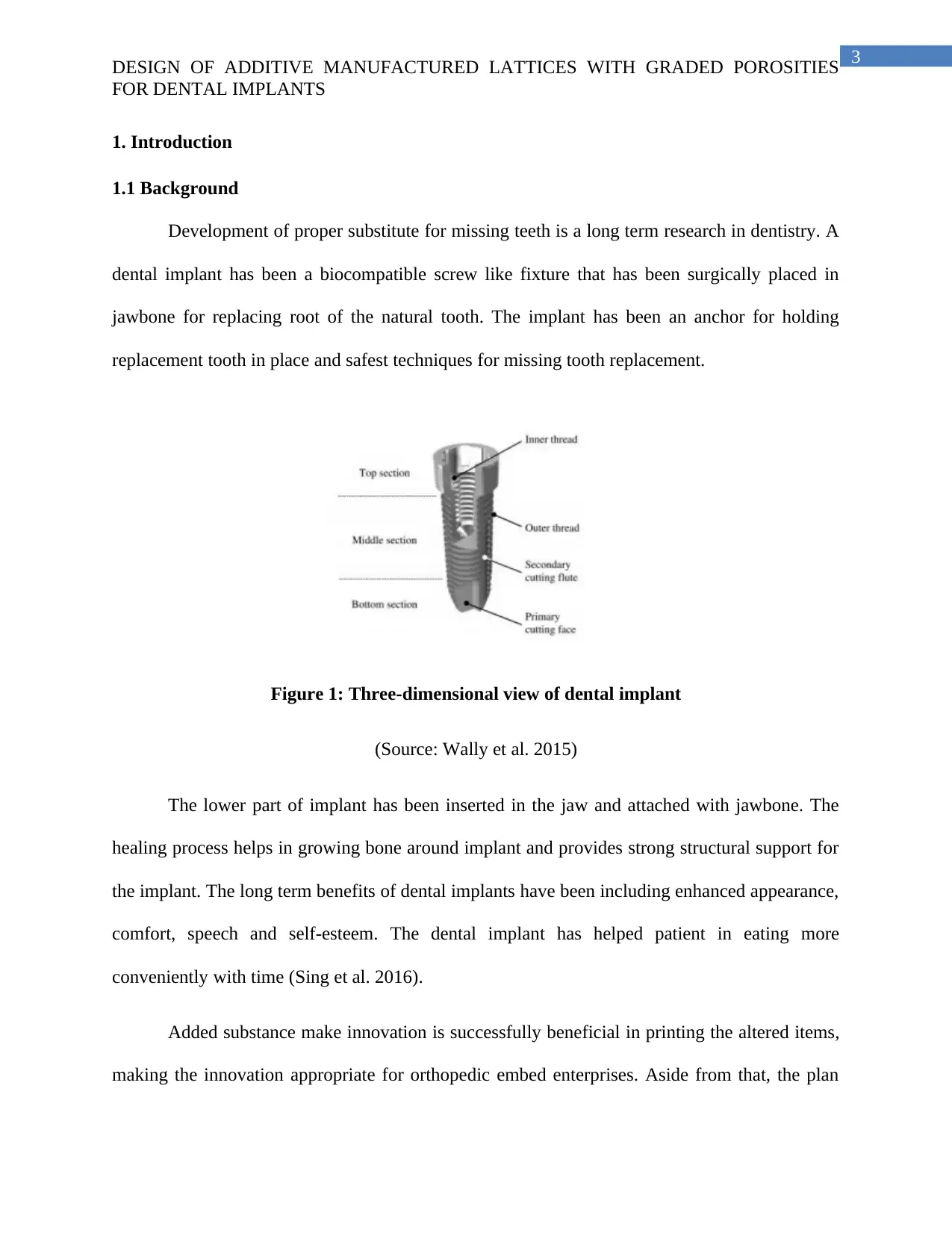
3
DESIGN OF ADDITIVE MANUFACTURED LATTICES WITH GRADED POROSITIES
FOR DENTAL IMPLANTS
1. Introduction
1.1 Background
Development of proper substitute for missing teeth is a long term research in dentistry. A
dental implant has been a biocompatible screw like fixture that has been surgically placed in
jawbone for replacing root of the natural tooth. The implant has been an anchor for holding
replacement tooth in place and safest techniques for missing tooth replacement.
Figure 1: Three-dimensional view of dental implant
(Source: Wally et al. 2015)
The lower part of implant has been inserted in the jaw and attached with jawbone. The
healing process helps in growing bone around implant and provides strong structural support for
the implant. The long term benefits of dental implants have been including enhanced appearance,
comfort, speech and self-esteem. The dental implant has helped patient in eating more
conveniently with time (Sing et al. 2016).
Added substance make innovation is successfully beneficial in printing the altered items,
making the innovation appropriate for orthopedic embed enterprises. Aside from that, the plan
DESIGN OF ADDITIVE MANUFACTURED LATTICES WITH GRADED POROSITIES
FOR DENTAL IMPLANTS
1. Introduction
1.1 Background
Development of proper substitute for missing teeth is a long term research in dentistry. A
dental implant has been a biocompatible screw like fixture that has been surgically placed in
jawbone for replacing root of the natural tooth. The implant has been an anchor for holding
replacement tooth in place and safest techniques for missing tooth replacement.
Figure 1: Three-dimensional view of dental implant
(Source: Wally et al. 2015)
The lower part of implant has been inserted in the jaw and attached with jawbone. The
healing process helps in growing bone around implant and provides strong structural support for
the implant. The long term benefits of dental implants have been including enhanced appearance,
comfort, speech and self-esteem. The dental implant has helped patient in eating more
conveniently with time (Sing et al. 2016).
Added substance make innovation is successfully beneficial in printing the altered items,
making the innovation appropriate for orthopedic embed enterprises. Aside from that, the plan
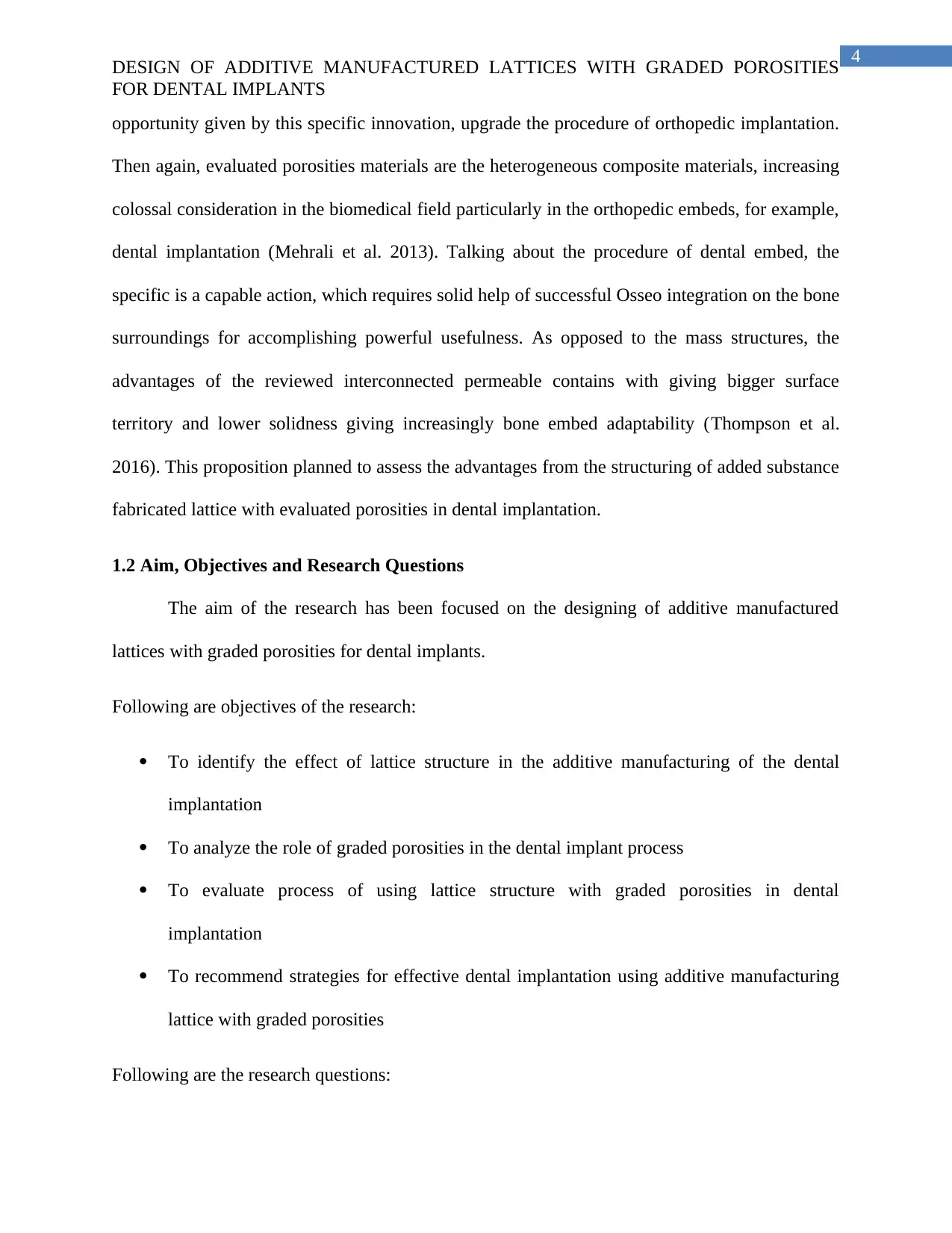
4
DESIGN OF ADDITIVE MANUFACTURED LATTICES WITH GRADED POROSITIES
FOR DENTAL IMPLANTS
opportunity given by this specific innovation, upgrade the procedure of orthopedic implantation.
Then again, evaluated porosities materials are the heterogeneous composite materials, increasing
colossal consideration in the biomedical field particularly in the orthopedic embeds, for example,
dental implantation (Mehrali et al. 2013). Talking about the procedure of dental embed, the
specific is a capable action, which requires solid help of successful Osseo integration on the bone
surroundings for accomplishing powerful usefulness. As opposed to the mass structures, the
advantages of the reviewed interconnected permeable contains with giving bigger surface
territory and lower solidness giving increasingly bone embed adaptability (Thompson et al.
2016). This proposition planned to assess the advantages from the structuring of added substance
fabricated lattice with evaluated porosities in dental implantation.
1.2 Aim, Objectives and Research Questions
The aim of the research has been focused on the designing of additive manufactured
lattices with graded porosities for dental implants.
Following are objectives of the research:
To identify the effect of lattice structure in the additive manufacturing of the dental
implantation
To analyze the role of graded porosities in the dental implant process
To evaluate process of using lattice structure with graded porosities in dental
implantation
To recommend strategies for effective dental implantation using additive manufacturing
lattice with graded porosities
Following are the research questions:
DESIGN OF ADDITIVE MANUFACTURED LATTICES WITH GRADED POROSITIES
FOR DENTAL IMPLANTS
opportunity given by this specific innovation, upgrade the procedure of orthopedic implantation.
Then again, evaluated porosities materials are the heterogeneous composite materials, increasing
colossal consideration in the biomedical field particularly in the orthopedic embeds, for example,
dental implantation (Mehrali et al. 2013). Talking about the procedure of dental embed, the
specific is a capable action, which requires solid help of successful Osseo integration on the bone
surroundings for accomplishing powerful usefulness. As opposed to the mass structures, the
advantages of the reviewed interconnected permeable contains with giving bigger surface
territory and lower solidness giving increasingly bone embed adaptability (Thompson et al.
2016). This proposition planned to assess the advantages from the structuring of added substance
fabricated lattice with evaluated porosities in dental implantation.
1.2 Aim, Objectives and Research Questions
The aim of the research has been focused on the designing of additive manufactured
lattices with graded porosities for dental implants.
Following are objectives of the research:
To identify the effect of lattice structure in the additive manufacturing of the dental
implantation
To analyze the role of graded porosities in the dental implant process
To evaluate process of using lattice structure with graded porosities in dental
implantation
To recommend strategies for effective dental implantation using additive manufacturing
lattice with graded porosities
Following are the research questions:
Secure Best Marks with AI Grader
Need help grading? Try our AI Grader for instant feedback on your assignments.
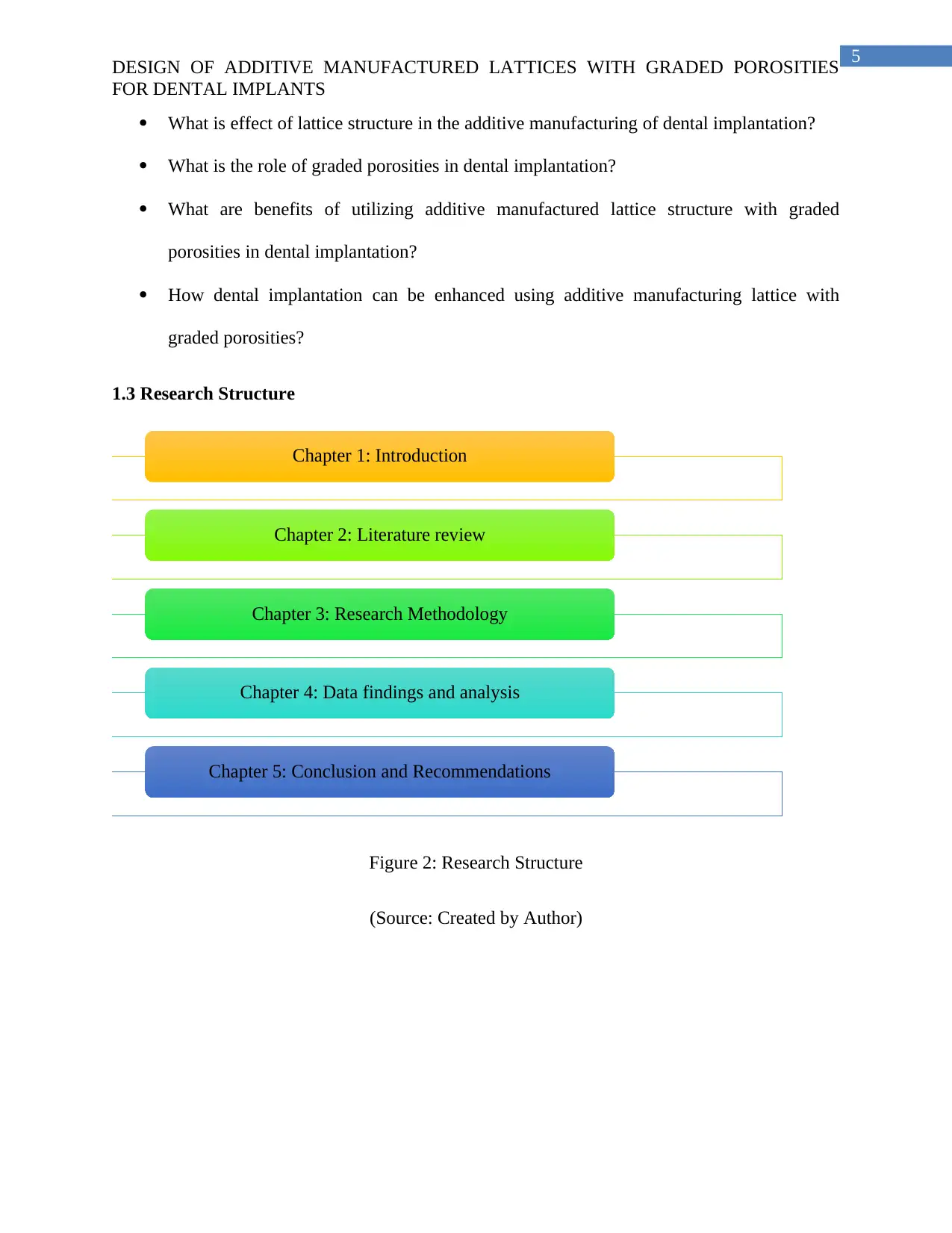
5
DESIGN OF ADDITIVE MANUFACTURED LATTICES WITH GRADED POROSITIES
FOR DENTAL IMPLANTS
What is effect of lattice structure in the additive manufacturing of dental implantation?
What is the role of graded porosities in dental implantation?
What are benefits of utilizing additive manufactured lattice structure with graded
porosities in dental implantation?
How dental implantation can be enhanced using additive manufacturing lattice with
graded porosities?
1.3 Research Structure
Figure 2: Research Structure
(Source: Created by Author)
Chapter 1: Introduction
Chapter 2: Literature review
Chapter 3: Research Methodology
Chapter 4: Data findings and analysis
Chapter 5: Conclusion and Recommendations
DESIGN OF ADDITIVE MANUFACTURED LATTICES WITH GRADED POROSITIES
FOR DENTAL IMPLANTS
What is effect of lattice structure in the additive manufacturing of dental implantation?
What is the role of graded porosities in dental implantation?
What are benefits of utilizing additive manufactured lattice structure with graded
porosities in dental implantation?
How dental implantation can be enhanced using additive manufacturing lattice with
graded porosities?
1.3 Research Structure
Figure 2: Research Structure
(Source: Created by Author)
Chapter 1: Introduction
Chapter 2: Literature review
Chapter 3: Research Methodology
Chapter 4: Data findings and analysis
Chapter 5: Conclusion and Recommendations
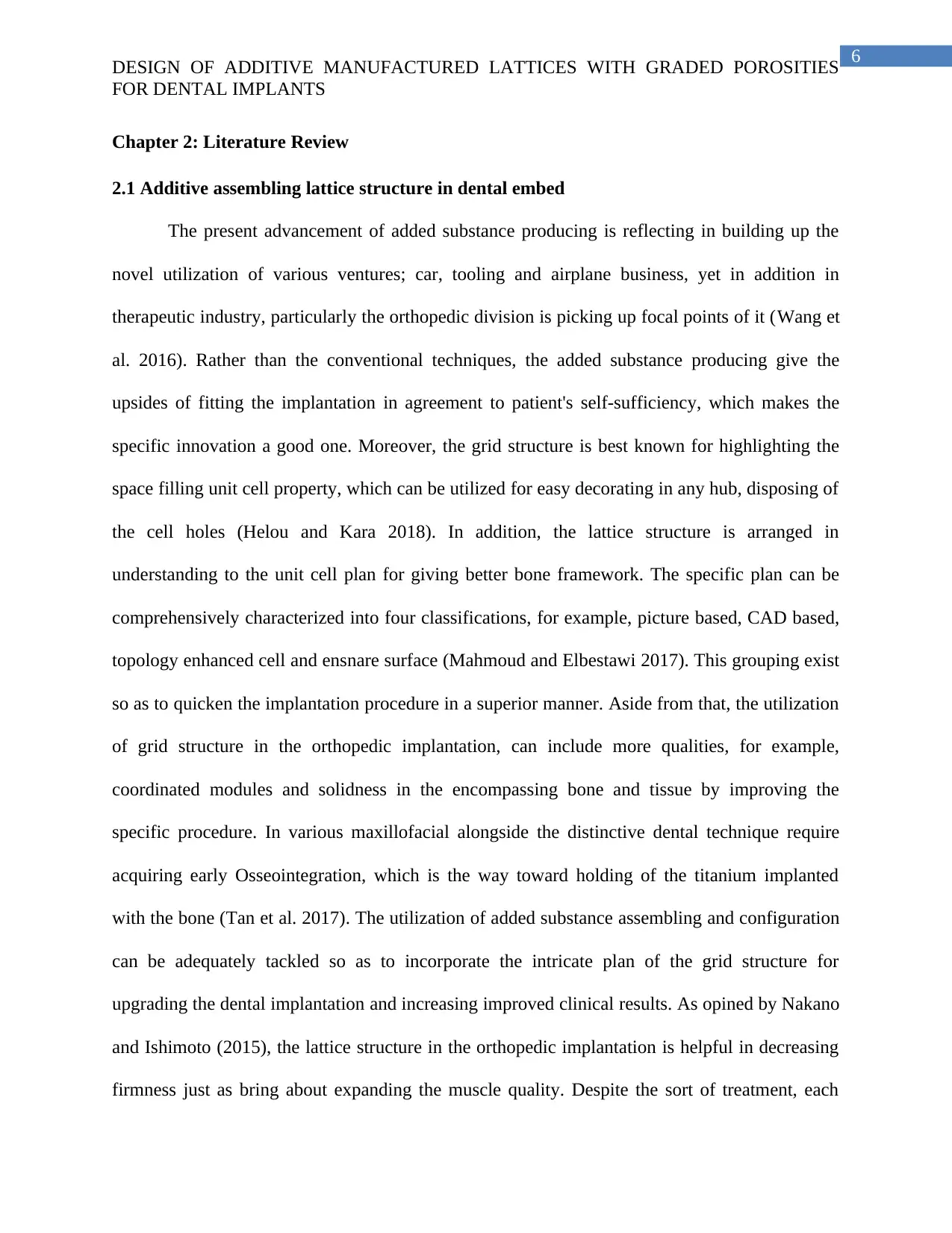
6
DESIGN OF ADDITIVE MANUFACTURED LATTICES WITH GRADED POROSITIES
FOR DENTAL IMPLANTS
Chapter 2: Literature Review
2.1 Additive assembling lattice structure in dental embed
The present advancement of added substance producing is reflecting in building up the
novel utilization of various ventures; car, tooling and airplane business, yet in addition in
therapeutic industry, particularly the orthopedic division is picking up focal points of it (Wang et
al. 2016). Rather than the conventional techniques, the added substance producing give the
upsides of fitting the implantation in agreement to patient's self-sufficiency, which makes the
specific innovation a good one. Moreover, the grid structure is best known for highlighting the
space filling unit cell property, which can be utilized for easy decorating in any hub, disposing of
the cell holes (Helou and Kara 2018). In addition, the lattice structure is arranged in
understanding to the unit cell plan for giving better bone framework. The specific plan can be
comprehensively characterized into four classifications, for example, picture based, CAD based,
topology enhanced cell and ensnare surface (Mahmoud and Elbestawi 2017). This grouping exist
so as to quicken the implantation procedure in a superior manner. Aside from that, the utilization
of grid structure in the orthopedic implantation, can include more qualities, for example,
coordinated modules and solidness in the encompassing bone and tissue by improving the
specific procedure. In various maxillofacial alongside the distinctive dental technique require
acquiring early Osseointegration, which is the way toward holding of the titanium implanted
with the bone (Tan et al. 2017). The utilization of added substance assembling and configuration
can be adequately tackled so as to incorporate the intricate plan of the grid structure for
upgrading the dental implantation and increasing improved clinical results. As opined by Nakano
and Ishimoto (2015), the lattice structure in the orthopedic implantation is helpful in decreasing
firmness just as bring about expanding the muscle quality. Despite the sort of treatment, each
DESIGN OF ADDITIVE MANUFACTURED LATTICES WITH GRADED POROSITIES
FOR DENTAL IMPLANTS
Chapter 2: Literature Review
2.1 Additive assembling lattice structure in dental embed
The present advancement of added substance producing is reflecting in building up the
novel utilization of various ventures; car, tooling and airplane business, yet in addition in
therapeutic industry, particularly the orthopedic division is picking up focal points of it (Wang et
al. 2016). Rather than the conventional techniques, the added substance producing give the
upsides of fitting the implantation in agreement to patient's self-sufficiency, which makes the
specific innovation a good one. Moreover, the grid structure is best known for highlighting the
space filling unit cell property, which can be utilized for easy decorating in any hub, disposing of
the cell holes (Helou and Kara 2018). In addition, the lattice structure is arranged in
understanding to the unit cell plan for giving better bone framework. The specific plan can be
comprehensively characterized into four classifications, for example, picture based, CAD based,
topology enhanced cell and ensnare surface (Mahmoud and Elbestawi 2017). This grouping exist
so as to quicken the implantation procedure in a superior manner. Aside from that, the utilization
of grid structure in the orthopedic implantation, can include more qualities, for example,
coordinated modules and solidness in the encompassing bone and tissue by improving the
specific procedure. In various maxillofacial alongside the distinctive dental technique require
acquiring early Osseointegration, which is the way toward holding of the titanium implanted
with the bone (Tan et al. 2017). The utilization of added substance assembling and configuration
can be adequately tackled so as to incorporate the intricate plan of the grid structure for
upgrading the dental implantation and increasing improved clinical results. As opined by Nakano
and Ishimoto (2015), the lattice structure in the orthopedic implantation is helpful in decreasing
firmness just as bring about expanding the muscle quality. Despite the sort of treatment, each
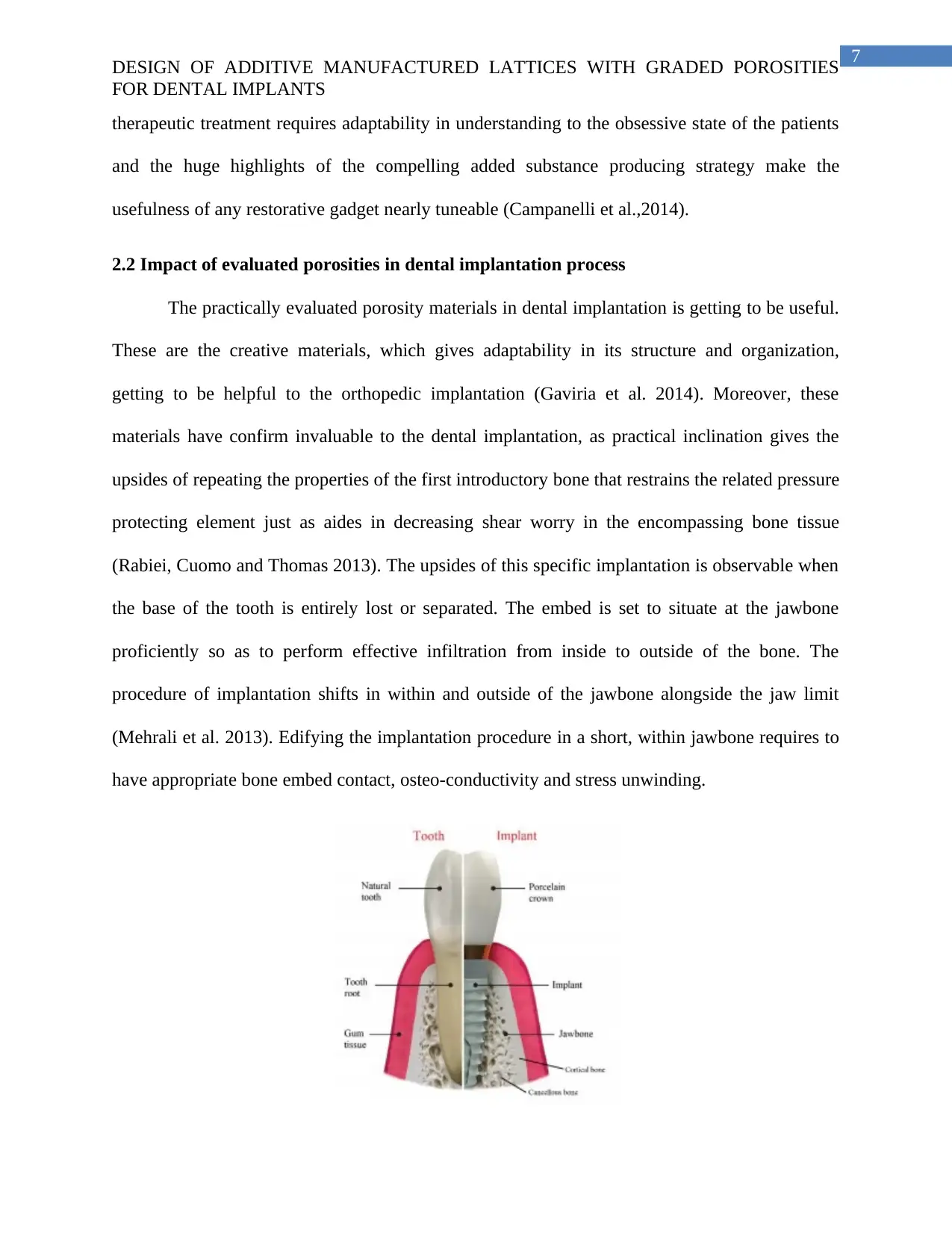
7
DESIGN OF ADDITIVE MANUFACTURED LATTICES WITH GRADED POROSITIES
FOR DENTAL IMPLANTS
therapeutic treatment requires adaptability in understanding to the obsessive state of the patients
and the huge highlights of the compelling added substance producing strategy make the
usefulness of any restorative gadget nearly tuneable (Campanelli et al.,2014).
2.2 Impact of evaluated porosities in dental implantation process
The practically evaluated porosity materials in dental implantation is getting to be useful.
These are the creative materials, which gives adaptability in its structure and organization,
getting to be helpful to the orthopedic implantation (Gaviria et al. 2014). Moreover, these
materials have confirm invaluable to the dental implantation, as practical inclination gives the
upsides of repeating the properties of the first introductory bone that restrains the related pressure
protecting element just as aides in decreasing shear worry in the encompassing bone tissue
(Rabiei, Cuomo and Thomas 2013). The upsides of this specific implantation is observable when
the base of the tooth is entirely lost or separated. The embed is set to situate at the jawbone
proficiently so as to perform effective infiltration from inside to outside of the bone. The
procedure of implantation shifts in within and outside of the jawbone alongside the jaw limit
(Mehrali et al. 2013). Edifying the implantation procedure in a short, within jawbone requires to
have appropriate bone embed contact, osteo-conductivity and stress unwinding.
DESIGN OF ADDITIVE MANUFACTURED LATTICES WITH GRADED POROSITIES
FOR DENTAL IMPLANTS
therapeutic treatment requires adaptability in understanding to the obsessive state of the patients
and the huge highlights of the compelling added substance producing strategy make the
usefulness of any restorative gadget nearly tuneable (Campanelli et al.,2014).
2.2 Impact of evaluated porosities in dental implantation process
The practically evaluated porosity materials in dental implantation is getting to be useful.
These are the creative materials, which gives adaptability in its structure and organization,
getting to be helpful to the orthopedic implantation (Gaviria et al. 2014). Moreover, these
materials have confirm invaluable to the dental implantation, as practical inclination gives the
upsides of repeating the properties of the first introductory bone that restrains the related pressure
protecting element just as aides in decreasing shear worry in the encompassing bone tissue
(Rabiei, Cuomo and Thomas 2013). The upsides of this specific implantation is observable when
the base of the tooth is entirely lost or separated. The embed is set to situate at the jawbone
proficiently so as to perform effective infiltration from inside to outside of the bone. The
procedure of implantation shifts in within and outside of the jawbone alongside the jaw limit
(Mehrali et al. 2013). Edifying the implantation procedure in a short, within jawbone requires to
have appropriate bone embed contact, osteo-conductivity and stress unwinding.
Paraphrase This Document
Need a fresh take? Get an instant paraphrase of this document with our AI Paraphraser
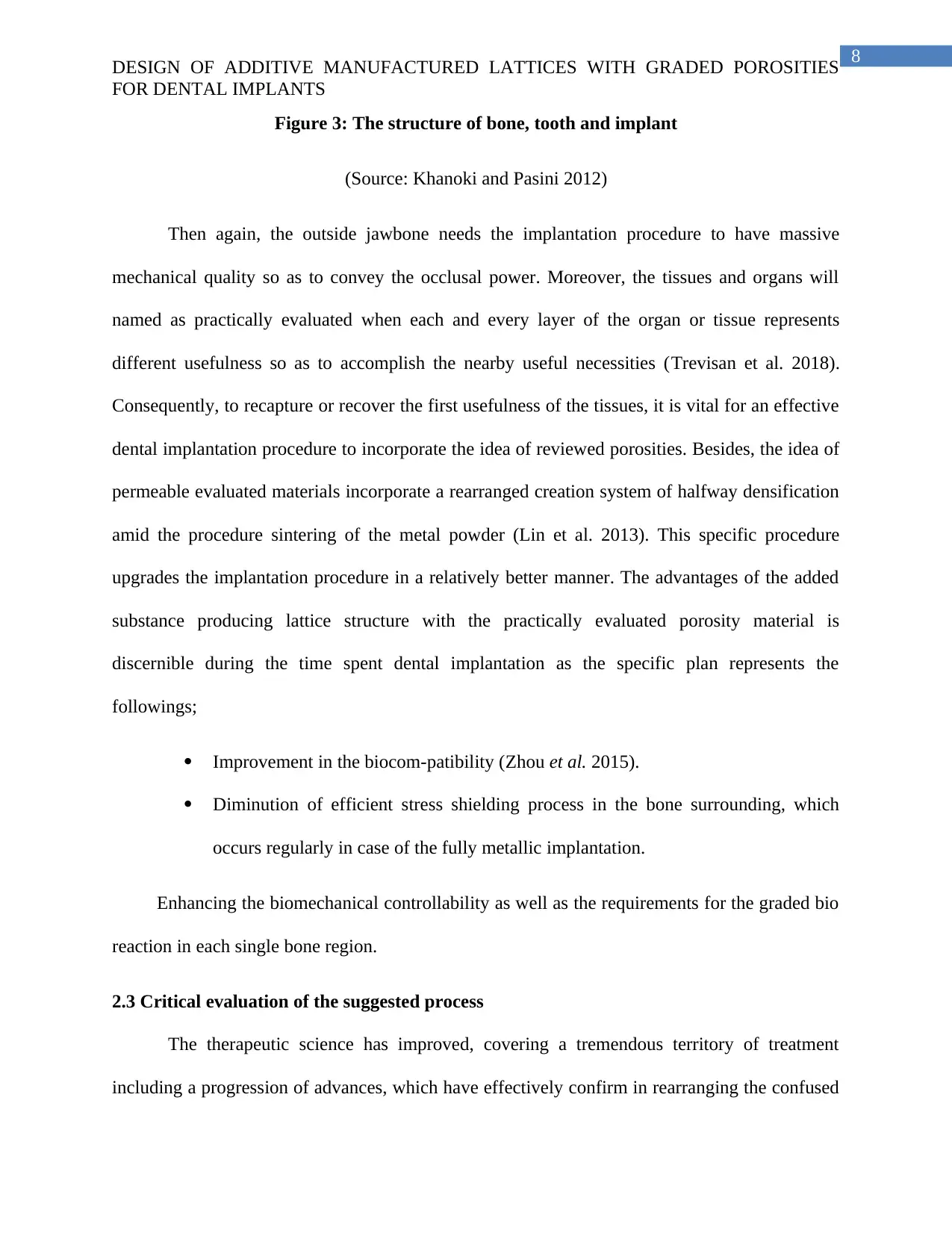
8
DESIGN OF ADDITIVE MANUFACTURED LATTICES WITH GRADED POROSITIES
FOR DENTAL IMPLANTS
Figure 3: The structure of bone, tooth and implant
(Source: Khanoki and Pasini 2012)
Then again, the outside jawbone needs the implantation procedure to have massive
mechanical quality so as to convey the occlusal power. Moreover, the tissues and organs will
named as practically evaluated when each and every layer of the organ or tissue represents
different usefulness so as to accomplish the nearby useful necessities (Trevisan et al. 2018).
Consequently, to recapture or recover the first usefulness of the tissues, it is vital for an effective
dental implantation procedure to incorporate the idea of reviewed porosities. Besides, the idea of
permeable evaluated materials incorporate a rearranged creation system of halfway densification
amid the procedure sintering of the metal powder (Lin et al. 2013). This specific procedure
upgrades the implantation procedure in a relatively better manner. The advantages of the added
substance producing lattice structure with the practically evaluated porosity material is
discernible during the time spent dental implantation as the specific plan represents the
followings;
Improvement in the biocom-patibility (Zhou et al. 2015).
Diminution of efficient stress shielding process in the bone surrounding, which
occurs regularly in case of the fully metallic implantation.
Enhancing the biomechanical controllability as well as the requirements for the graded bio
reaction in each single bone region.
2.3 Critical evaluation of the suggested process
The therapeutic science has improved, covering a tremendous territory of treatment
including a progression of advances, which have effectively confirm in rearranging the confused
DESIGN OF ADDITIVE MANUFACTURED LATTICES WITH GRADED POROSITIES
FOR DENTAL IMPLANTS
Figure 3: The structure of bone, tooth and implant
(Source: Khanoki and Pasini 2012)
Then again, the outside jawbone needs the implantation procedure to have massive
mechanical quality so as to convey the occlusal power. Moreover, the tissues and organs will
named as practically evaluated when each and every layer of the organ or tissue represents
different usefulness so as to accomplish the nearby useful necessities (Trevisan et al. 2018).
Consequently, to recapture or recover the first usefulness of the tissues, it is vital for an effective
dental implantation procedure to incorporate the idea of reviewed porosities. Besides, the idea of
permeable evaluated materials incorporate a rearranged creation system of halfway densification
amid the procedure sintering of the metal powder (Lin et al. 2013). This specific procedure
upgrades the implantation procedure in a relatively better manner. The advantages of the added
substance producing lattice structure with the practically evaluated porosity material is
discernible during the time spent dental implantation as the specific plan represents the
followings;
Improvement in the biocom-patibility (Zhou et al. 2015).
Diminution of efficient stress shielding process in the bone surrounding, which
occurs regularly in case of the fully metallic implantation.
Enhancing the biomechanical controllability as well as the requirements for the graded bio
reaction in each single bone region.
2.3 Critical evaluation of the suggested process
The therapeutic science has improved, covering a tremendous territory of treatment
including a progression of advances, which have effectively confirm in rearranging the confused
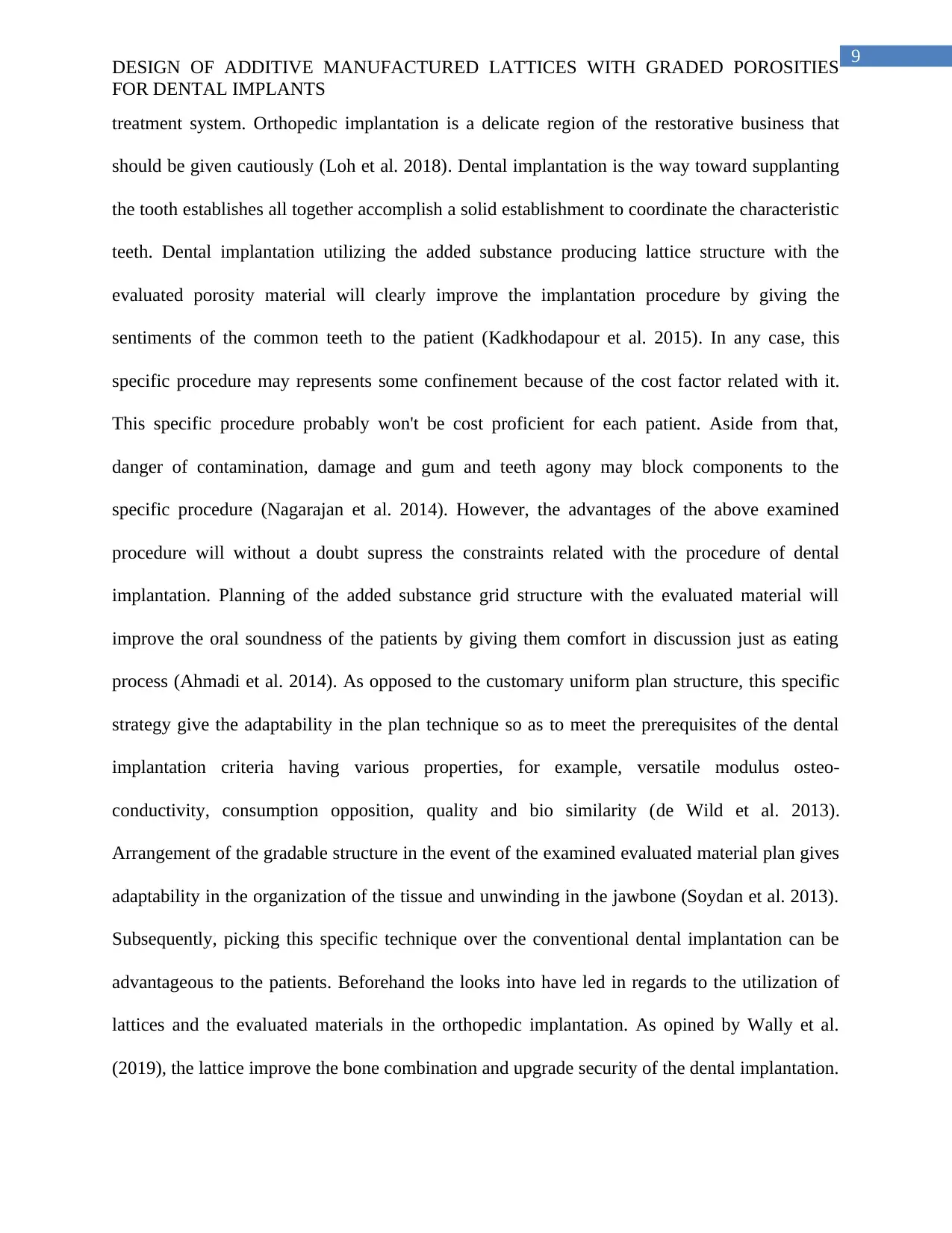
9
DESIGN OF ADDITIVE MANUFACTURED LATTICES WITH GRADED POROSITIES
FOR DENTAL IMPLANTS
treatment system. Orthopedic implantation is a delicate region of the restorative business that
should be given cautiously (Loh et al. 2018). Dental implantation is the way toward supplanting
the tooth establishes all together accomplish a solid establishment to coordinate the characteristic
teeth. Dental implantation utilizing the added substance producing lattice structure with the
evaluated porosity material will clearly improve the implantation procedure by giving the
sentiments of the common teeth to the patient (Kadkhodapour et al. 2015). In any case, this
specific procedure may represents some confinement because of the cost factor related with it.
This specific procedure probably won't be cost proficient for each patient. Aside from that,
danger of contamination, damage and gum and teeth agony may block components to the
specific procedure (Nagarajan et al. 2014). However, the advantages of the above examined
procedure will without a doubt supress the constraints related with the procedure of dental
implantation. Planning of the added substance grid structure with the evaluated material will
improve the oral soundness of the patients by giving them comfort in discussion just as eating
process (Ahmadi et al. 2014). As opposed to the customary uniform plan structure, this specific
strategy give the adaptability in the plan technique so as to meet the prerequisites of the dental
implantation criteria having various properties, for example, versatile modulus osteo-
conductivity, consumption opposition, quality and bio similarity (de Wild et al. 2013).
Arrangement of the gradable structure in the event of the examined evaluated material plan gives
adaptability in the organization of the tissue and unwinding in the jawbone (Soydan et al. 2013).
Subsequently, picking this specific technique over the conventional dental implantation can be
advantageous to the patients. Beforehand the looks into have led in regards to the utilization of
lattices and the evaluated materials in the orthopedic implantation. As opined by Wally et al.
(2019), the lattice improve the bone combination and upgrade security of the dental implantation.
DESIGN OF ADDITIVE MANUFACTURED LATTICES WITH GRADED POROSITIES
FOR DENTAL IMPLANTS
treatment system. Orthopedic implantation is a delicate region of the restorative business that
should be given cautiously (Loh et al. 2018). Dental implantation is the way toward supplanting
the tooth establishes all together accomplish a solid establishment to coordinate the characteristic
teeth. Dental implantation utilizing the added substance producing lattice structure with the
evaluated porosity material will clearly improve the implantation procedure by giving the
sentiments of the common teeth to the patient (Kadkhodapour et al. 2015). In any case, this
specific procedure may represents some confinement because of the cost factor related with it.
This specific procedure probably won't be cost proficient for each patient. Aside from that,
danger of contamination, damage and gum and teeth agony may block components to the
specific procedure (Nagarajan et al. 2014). However, the advantages of the above examined
procedure will without a doubt supress the constraints related with the procedure of dental
implantation. Planning of the added substance grid structure with the evaluated material will
improve the oral soundness of the patients by giving them comfort in discussion just as eating
process (Ahmadi et al. 2014). As opposed to the customary uniform plan structure, this specific
strategy give the adaptability in the plan technique so as to meet the prerequisites of the dental
implantation criteria having various properties, for example, versatile modulus osteo-
conductivity, consumption opposition, quality and bio similarity (de Wild et al. 2013).
Arrangement of the gradable structure in the event of the examined evaluated material plan gives
adaptability in the organization of the tissue and unwinding in the jawbone (Soydan et al. 2013).
Subsequently, picking this specific technique over the conventional dental implantation can be
advantageous to the patients. Beforehand the looks into have led in regards to the utilization of
lattices and the evaluated materials in the orthopedic implantation. As opined by Wally et al.
(2019), the lattice improve the bone combination and upgrade security of the dental implantation.
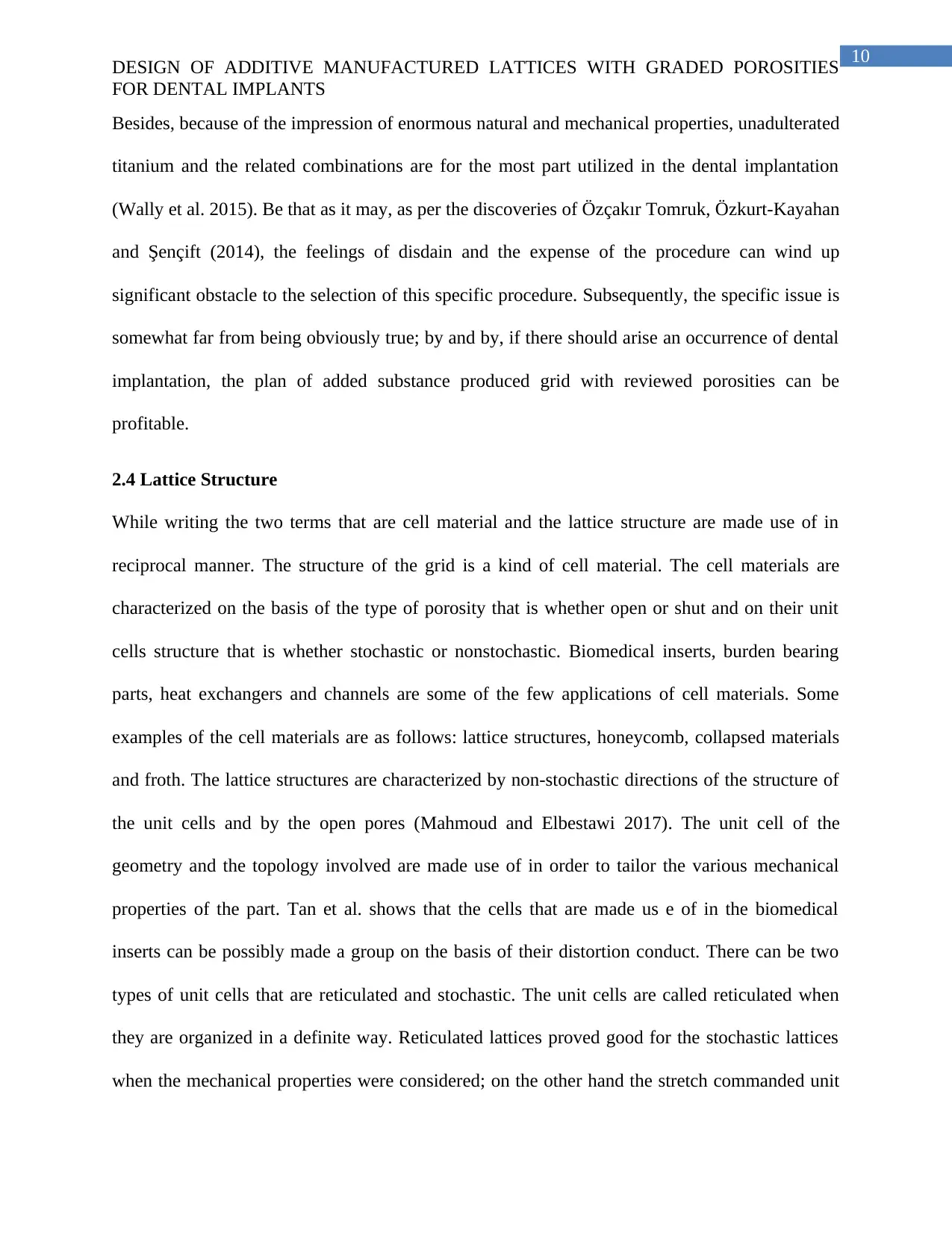
10
DESIGN OF ADDITIVE MANUFACTURED LATTICES WITH GRADED POROSITIES
FOR DENTAL IMPLANTS
Besides, because of the impression of enormous natural and mechanical properties, unadulterated
titanium and the related combinations are for the most part utilized in the dental implantation
(Wally et al. 2015). Be that as it may, as per the discoveries of Özçakır Tomruk, Özkurt-Kayahan
and Şençift (2014), the feelings of disdain and the expense of the procedure can wind up
significant obstacle to the selection of this specific procedure. Subsequently, the specific issue is
somewhat far from being obviously true; by and by, if there should arise an occurrence of dental
implantation, the plan of added substance produced grid with reviewed porosities can be
profitable.
2.4 Lattice Structure
While writing the two terms that are cell material and the lattice structure are made use of in
reciprocal manner. The structure of the grid is a kind of cell material. The cell materials are
characterized on the basis of the type of porosity that is whether open or shut and on their unit
cells structure that is whether stochastic or nonstochastic. Biomedical inserts, burden bearing
parts, heat exchangers and channels are some of the few applications of cell materials. Some
examples of the cell materials are as follows: lattice structures, honeycomb, collapsed materials
and froth. The lattice structures are characterized by non-stochastic directions of the structure of
the unit cells and by the open pores (Mahmoud and Elbestawi 2017). The unit cell of the
geometry and the topology involved are made use of in order to tailor the various mechanical
properties of the part. Tan et al. shows that the cells that are made us e of in the biomedical
inserts can be possibly made a group on the basis of their distortion conduct. There can be two
types of unit cells that are reticulated and stochastic. The unit cells are called reticulated when
they are organized in a definite way. Reticulated lattices proved good for the stochastic lattices
when the mechanical properties were considered; on the other hand the stretch commanded unit
DESIGN OF ADDITIVE MANUFACTURED LATTICES WITH GRADED POROSITIES
FOR DENTAL IMPLANTS
Besides, because of the impression of enormous natural and mechanical properties, unadulterated
titanium and the related combinations are for the most part utilized in the dental implantation
(Wally et al. 2015). Be that as it may, as per the discoveries of Özçakır Tomruk, Özkurt-Kayahan
and Şençift (2014), the feelings of disdain and the expense of the procedure can wind up
significant obstacle to the selection of this specific procedure. Subsequently, the specific issue is
somewhat far from being obviously true; by and by, if there should arise an occurrence of dental
implantation, the plan of added substance produced grid with reviewed porosities can be
profitable.
2.4 Lattice Structure
While writing the two terms that are cell material and the lattice structure are made use of in
reciprocal manner. The structure of the grid is a kind of cell material. The cell materials are
characterized on the basis of the type of porosity that is whether open or shut and on their unit
cells structure that is whether stochastic or nonstochastic. Biomedical inserts, burden bearing
parts, heat exchangers and channels are some of the few applications of cell materials. Some
examples of the cell materials are as follows: lattice structures, honeycomb, collapsed materials
and froth. The lattice structures are characterized by non-stochastic directions of the structure of
the unit cells and by the open pores (Mahmoud and Elbestawi 2017). The unit cell of the
geometry and the topology involved are made use of in order to tailor the various mechanical
properties of the part. Tan et al. shows that the cells that are made us e of in the biomedical
inserts can be possibly made a group on the basis of their distortion conduct. There can be two
types of unit cells that are reticulated and stochastic. The unit cells are called reticulated when
they are organized in a definite way. Reticulated lattices proved good for the stochastic lattices
when the mechanical properties were considered; on the other hand the stretch commanded unit
Secure Best Marks with AI Grader
Need help grading? Try our AI Grader for instant feedback on your assignments.
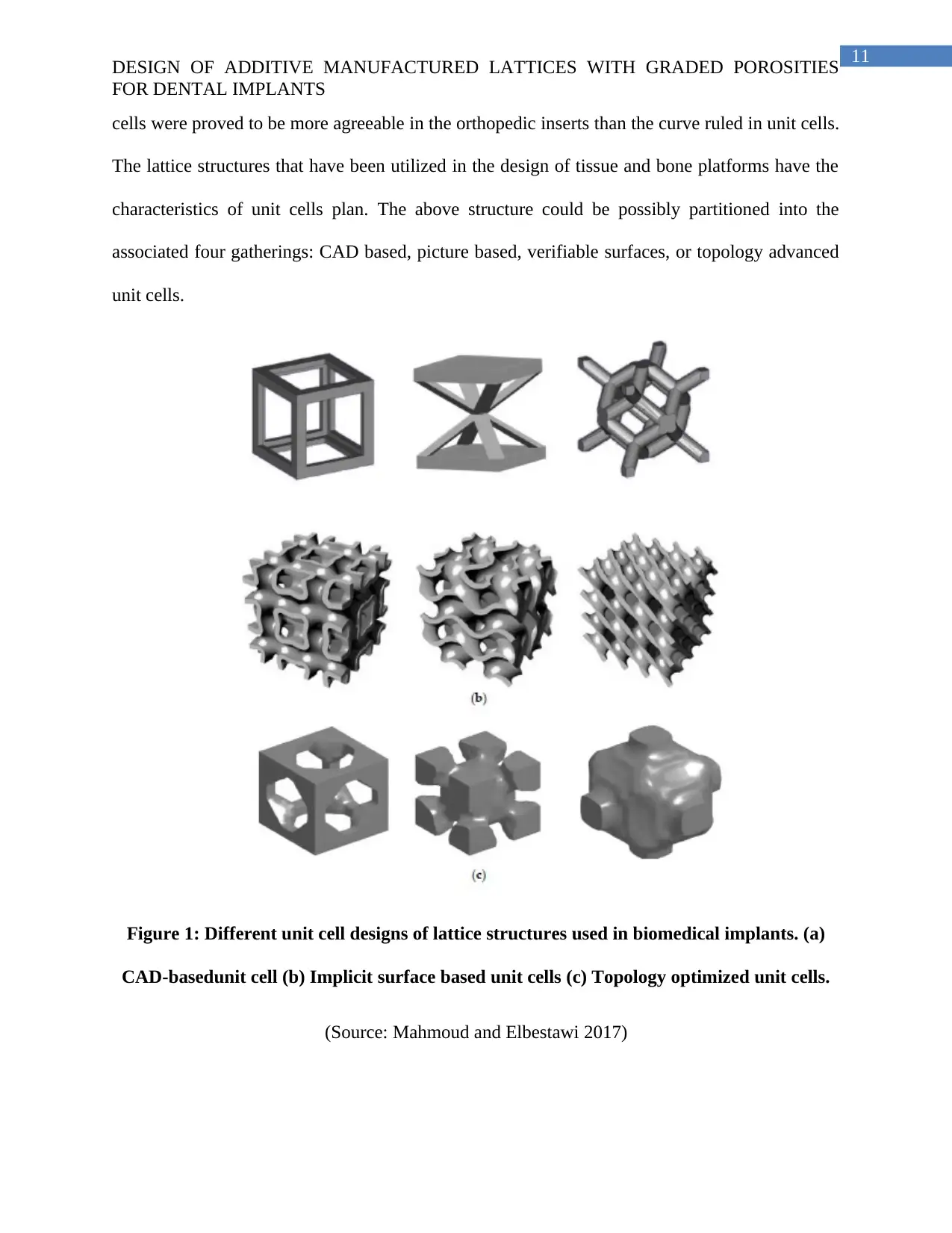
11
DESIGN OF ADDITIVE MANUFACTURED LATTICES WITH GRADED POROSITIES
FOR DENTAL IMPLANTS
cells were proved to be more agreeable in the orthopedic inserts than the curve ruled in unit cells.
The lattice structures that have been utilized in the design of tissue and bone platforms have the
characteristics of unit cells plan. The above structure could be possibly partitioned into the
associated four gatherings: CAD based, picture based, verifiable surfaces, or topology advanced
unit cells.
Figure 1: Different unit cell designs of lattice structures used in biomedical implants. (a)
CAD-basedunit cell (b) Implicit surface based unit cells (c) Topology optimized unit cells.
(Source: Mahmoud and Elbestawi 2017)
DESIGN OF ADDITIVE MANUFACTURED LATTICES WITH GRADED POROSITIES
FOR DENTAL IMPLANTS
cells were proved to be more agreeable in the orthopedic inserts than the curve ruled in unit cells.
The lattice structures that have been utilized in the design of tissue and bone platforms have the
characteristics of unit cells plan. The above structure could be possibly partitioned into the
associated four gatherings: CAD based, picture based, verifiable surfaces, or topology advanced
unit cells.
Figure 1: Different unit cell designs of lattice structures used in biomedical implants. (a)
CAD-basedunit cell (b) Implicit surface based unit cells (c) Topology optimized unit cells.
(Source: Mahmoud and Elbestawi 2017)
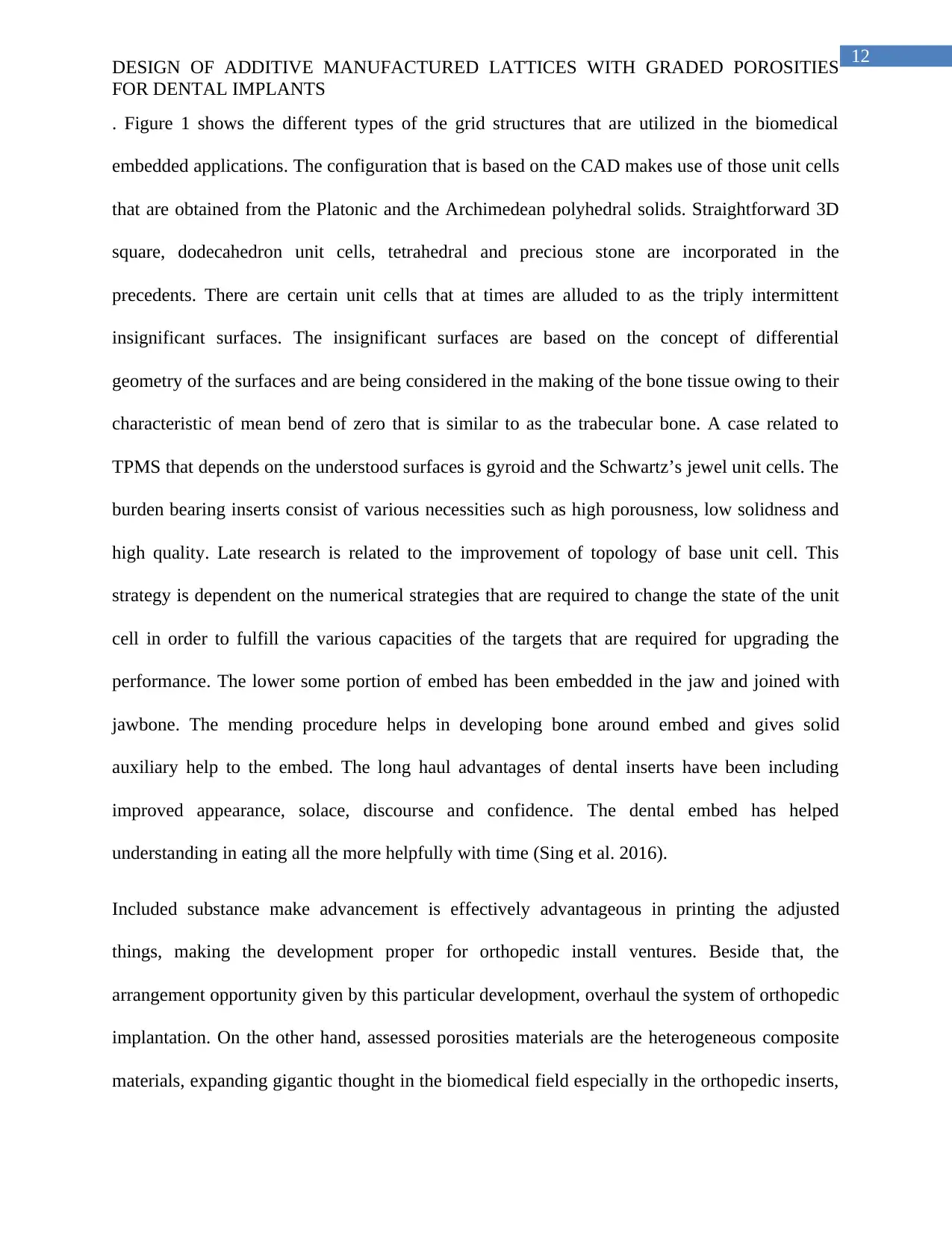
12
DESIGN OF ADDITIVE MANUFACTURED LATTICES WITH GRADED POROSITIES
FOR DENTAL IMPLANTS
. Figure 1 shows the different types of the grid structures that are utilized in the biomedical
embedded applications. The configuration that is based on the CAD makes use of those unit cells
that are obtained from the Platonic and the Archimedean polyhedral solids. Straightforward 3D
square, dodecahedron unit cells, tetrahedral and precious stone are incorporated in the
precedents. There are certain unit cells that at times are alluded to as the triply intermittent
insignificant surfaces. The insignificant surfaces are based on the concept of differential
geometry of the surfaces and are being considered in the making of the bone tissue owing to their
characteristic of mean bend of zero that is similar to as the trabecular bone. A case related to
TPMS that depends on the understood surfaces is gyroid and the Schwartz’s jewel unit cells. The
burden bearing inserts consist of various necessities such as high porousness, low solidness and
high quality. Late research is related to the improvement of topology of base unit cell. This
strategy is dependent on the numerical strategies that are required to change the state of the unit
cell in order to fulfill the various capacities of the targets that are required for upgrading the
performance. The lower some portion of embed has been embedded in the jaw and joined with
jawbone. The mending procedure helps in developing bone around embed and gives solid
auxiliary help to the embed. The long haul advantages of dental inserts have been including
improved appearance, solace, discourse and confidence. The dental embed has helped
understanding in eating all the more helpfully with time (Sing et al. 2016).
Included substance make advancement is effectively advantageous in printing the adjusted
things, making the development proper for orthopedic install ventures. Beside that, the
arrangement opportunity given by this particular development, overhaul the system of orthopedic
implantation. On the other hand, assessed porosities materials are the heterogeneous composite
materials, expanding gigantic thought in the biomedical field especially in the orthopedic inserts,
DESIGN OF ADDITIVE MANUFACTURED LATTICES WITH GRADED POROSITIES
FOR DENTAL IMPLANTS
. Figure 1 shows the different types of the grid structures that are utilized in the biomedical
embedded applications. The configuration that is based on the CAD makes use of those unit cells
that are obtained from the Platonic and the Archimedean polyhedral solids. Straightforward 3D
square, dodecahedron unit cells, tetrahedral and precious stone are incorporated in the
precedents. There are certain unit cells that at times are alluded to as the triply intermittent
insignificant surfaces. The insignificant surfaces are based on the concept of differential
geometry of the surfaces and are being considered in the making of the bone tissue owing to their
characteristic of mean bend of zero that is similar to as the trabecular bone. A case related to
TPMS that depends on the understood surfaces is gyroid and the Schwartz’s jewel unit cells. The
burden bearing inserts consist of various necessities such as high porousness, low solidness and
high quality. Late research is related to the improvement of topology of base unit cell. This
strategy is dependent on the numerical strategies that are required to change the state of the unit
cell in order to fulfill the various capacities of the targets that are required for upgrading the
performance. The lower some portion of embed has been embedded in the jaw and joined with
jawbone. The mending procedure helps in developing bone around embed and gives solid
auxiliary help to the embed. The long haul advantages of dental inserts have been including
improved appearance, solace, discourse and confidence. The dental embed has helped
understanding in eating all the more helpfully with time (Sing et al. 2016).
Included substance make advancement is effectively advantageous in printing the adjusted
things, making the development proper for orthopedic install ventures. Beside that, the
arrangement opportunity given by this particular development, overhaul the system of orthopedic
implantation. On the other hand, assessed porosities materials are the heterogeneous composite
materials, expanding gigantic thought in the biomedical field especially in the orthopedic inserts,
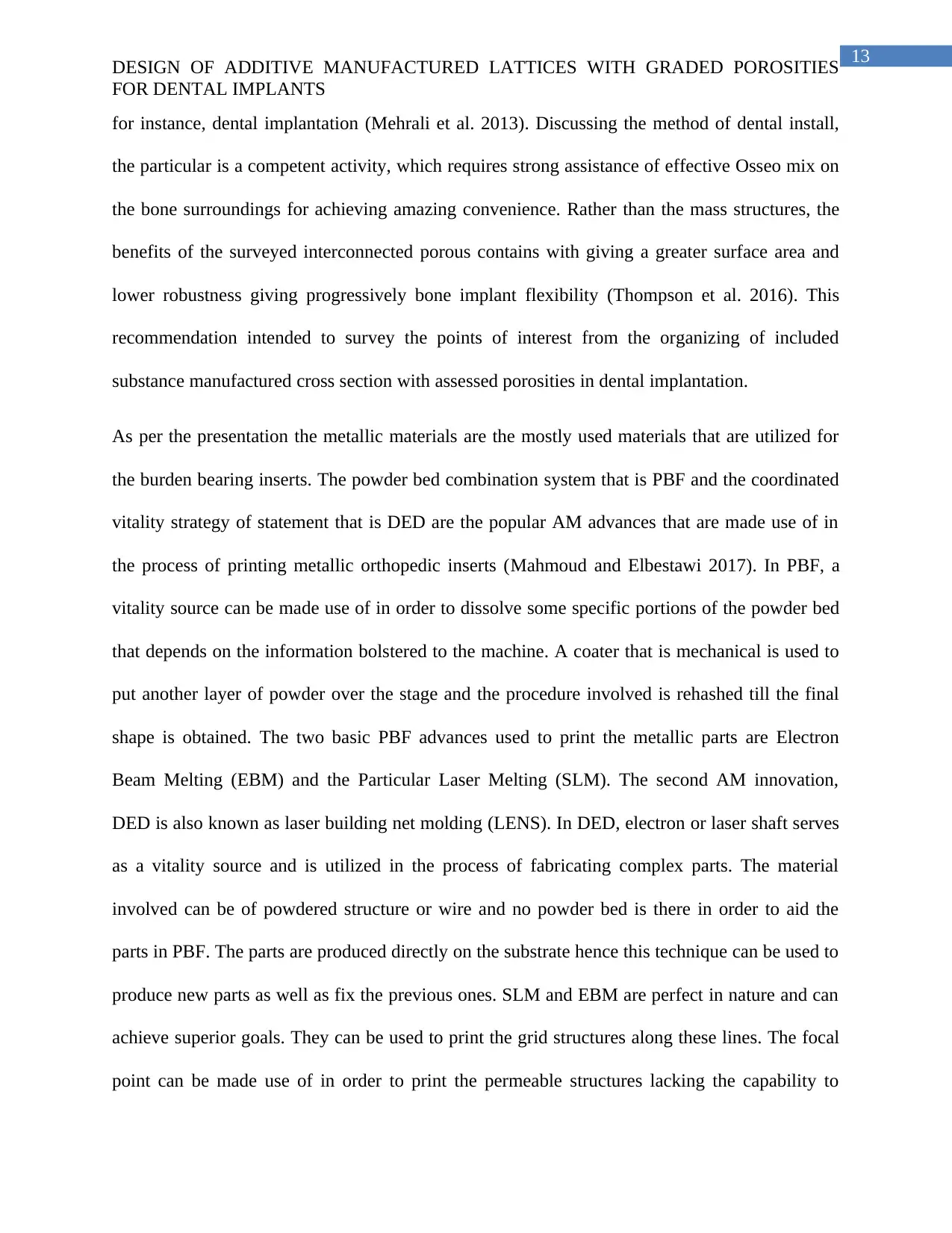
13
DESIGN OF ADDITIVE MANUFACTURED LATTICES WITH GRADED POROSITIES
FOR DENTAL IMPLANTS
for instance, dental implantation (Mehrali et al. 2013). Discussing the method of dental install,
the particular is a competent activity, which requires strong assistance of effective Osseo mix on
the bone surroundings for achieving amazing convenience. Rather than the mass structures, the
benefits of the surveyed interconnected porous contains with giving a greater surface area and
lower robustness giving progressively bone implant flexibility (Thompson et al. 2016). This
recommendation intended to survey the points of interest from the organizing of included
substance manufactured cross section with assessed porosities in dental implantation.
As per the presentation the metallic materials are the mostly used materials that are utilized for
the burden bearing inserts. The powder bed combination system that is PBF and the coordinated
vitality strategy of statement that is DED are the popular AM advances that are made use of in
the process of printing metallic orthopedic inserts (Mahmoud and Elbestawi 2017). In PBF, a
vitality source can be made use of in order to dissolve some specific portions of the powder bed
that depends on the information bolstered to the machine. A coater that is mechanical is used to
put another layer of powder over the stage and the procedure involved is rehashed till the final
shape is obtained. The two basic PBF advances used to print the metallic parts are Electron
Beam Melting (EBM) and the Particular Laser Melting (SLM). The second AM innovation,
DED is also known as laser building net molding (LENS). In DED, electron or laser shaft serves
as a vitality source and is utilized in the process of fabricating complex parts. The material
involved can be of powdered structure or wire and no powder bed is there in order to aid the
parts in PBF. The parts are produced directly on the substrate hence this technique can be used to
produce new parts as well as fix the previous ones. SLM and EBM are perfect in nature and can
achieve superior goals. They can be used to print the grid structures along these lines. The focal
point can be made use of in order to print the permeable structures lacking the capability to
DESIGN OF ADDITIVE MANUFACTURED LATTICES WITH GRADED POROSITIES
FOR DENTAL IMPLANTS
for instance, dental implantation (Mehrali et al. 2013). Discussing the method of dental install,
the particular is a competent activity, which requires strong assistance of effective Osseo mix on
the bone surroundings for achieving amazing convenience. Rather than the mass structures, the
benefits of the surveyed interconnected porous contains with giving a greater surface area and
lower robustness giving progressively bone implant flexibility (Thompson et al. 2016). This
recommendation intended to survey the points of interest from the organizing of included
substance manufactured cross section with assessed porosities in dental implantation.
As per the presentation the metallic materials are the mostly used materials that are utilized for
the burden bearing inserts. The powder bed combination system that is PBF and the coordinated
vitality strategy of statement that is DED are the popular AM advances that are made use of in
the process of printing metallic orthopedic inserts (Mahmoud and Elbestawi 2017). In PBF, a
vitality source can be made use of in order to dissolve some specific portions of the powder bed
that depends on the information bolstered to the machine. A coater that is mechanical is used to
put another layer of powder over the stage and the procedure involved is rehashed till the final
shape is obtained. The two basic PBF advances used to print the metallic parts are Electron
Beam Melting (EBM) and the Particular Laser Melting (SLM). The second AM innovation,
DED is also known as laser building net molding (LENS). In DED, electron or laser shaft serves
as a vitality source and is utilized in the process of fabricating complex parts. The material
involved can be of powdered structure or wire and no powder bed is there in order to aid the
parts in PBF. The parts are produced directly on the substrate hence this technique can be used to
produce new parts as well as fix the previous ones. SLM and EBM are perfect in nature and can
achieve superior goals. They can be used to print the grid structures along these lines. The focal
point can be made use of in order to print the permeable structures lacking the capability to
Paraphrase This Document
Need a fresh take? Get an instant paraphrase of this document with our AI Paraphraser
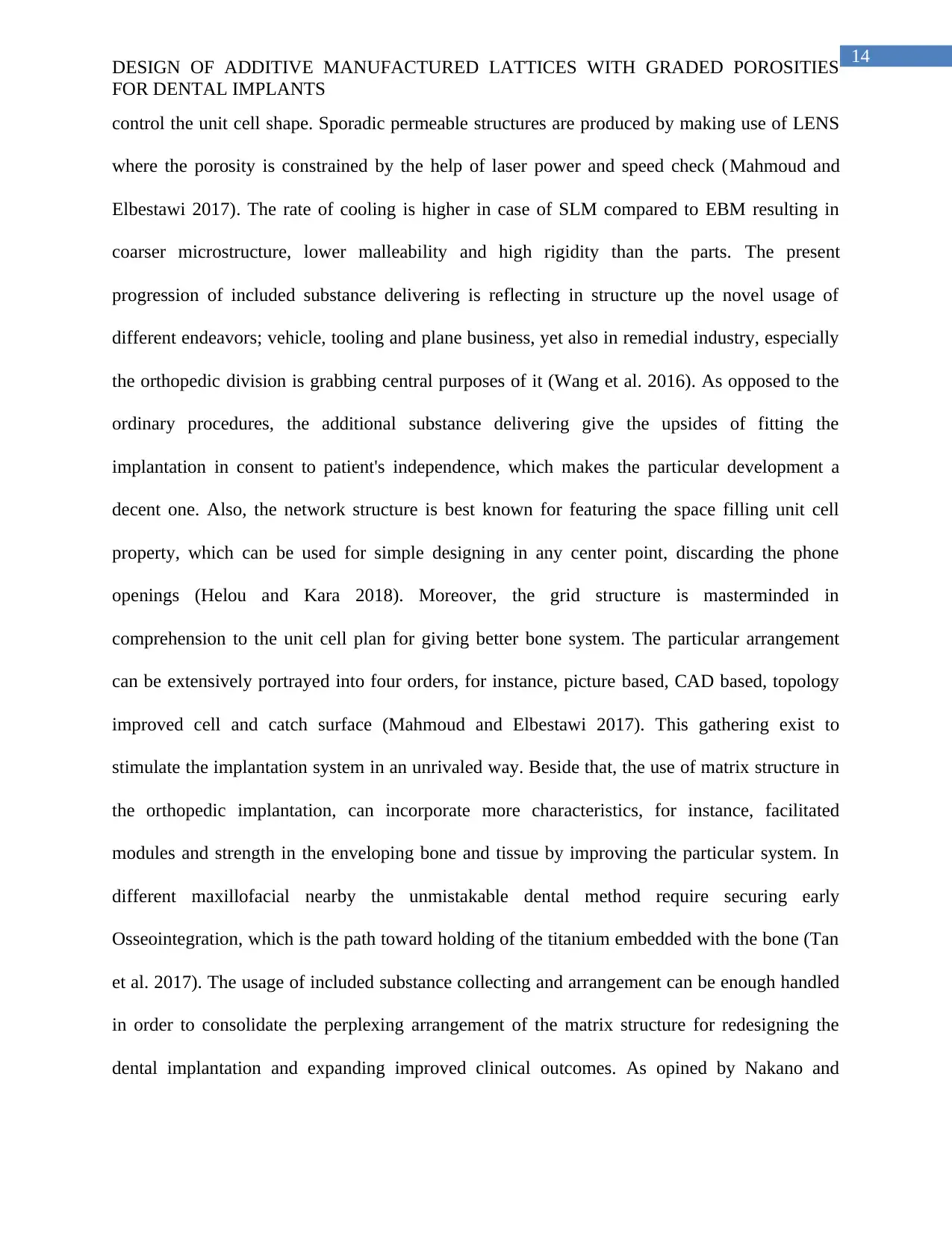
14
DESIGN OF ADDITIVE MANUFACTURED LATTICES WITH GRADED POROSITIES
FOR DENTAL IMPLANTS
control the unit cell shape. Sporadic permeable structures are produced by making use of LENS
where the porosity is constrained by the help of laser power and speed check (Mahmoud and
Elbestawi 2017). The rate of cooling is higher in case of SLM compared to EBM resulting in
coarser microstructure, lower malleability and high rigidity than the parts. The present
progression of included substance delivering is reflecting in structure up the novel usage of
different endeavors; vehicle, tooling and plane business, yet also in remedial industry, especially
the orthopedic division is grabbing central purposes of it (Wang et al. 2016). As opposed to the
ordinary procedures, the additional substance delivering give the upsides of fitting the
implantation in consent to patient's independence, which makes the particular development a
decent one. Also, the network structure is best known for featuring the space filling unit cell
property, which can be used for simple designing in any center point, discarding the phone
openings (Helou and Kara 2018). Moreover, the grid structure is masterminded in
comprehension to the unit cell plan for giving better bone system. The particular arrangement
can be extensively portrayed into four orders, for instance, picture based, CAD based, topology
improved cell and catch surface (Mahmoud and Elbestawi 2017). This gathering exist to
stimulate the implantation system in an unrivaled way. Beside that, the use of matrix structure in
the orthopedic implantation, can incorporate more characteristics, for instance, facilitated
modules and strength in the enveloping bone and tissue by improving the particular system. In
different maxillofacial nearby the unmistakable dental method require securing early
Osseointegration, which is the path toward holding of the titanium embedded with the bone (Tan
et al. 2017). The usage of included substance collecting and arrangement can be enough handled
in order to consolidate the perplexing arrangement of the matrix structure for redesigning the
dental implantation and expanding improved clinical outcomes. As opined by Nakano and
DESIGN OF ADDITIVE MANUFACTURED LATTICES WITH GRADED POROSITIES
FOR DENTAL IMPLANTS
control the unit cell shape. Sporadic permeable structures are produced by making use of LENS
where the porosity is constrained by the help of laser power and speed check (Mahmoud and
Elbestawi 2017). The rate of cooling is higher in case of SLM compared to EBM resulting in
coarser microstructure, lower malleability and high rigidity than the parts. The present
progression of included substance delivering is reflecting in structure up the novel usage of
different endeavors; vehicle, tooling and plane business, yet also in remedial industry, especially
the orthopedic division is grabbing central purposes of it (Wang et al. 2016). As opposed to the
ordinary procedures, the additional substance delivering give the upsides of fitting the
implantation in consent to patient's independence, which makes the particular development a
decent one. Also, the network structure is best known for featuring the space filling unit cell
property, which can be used for simple designing in any center point, discarding the phone
openings (Helou and Kara 2018). Moreover, the grid structure is masterminded in
comprehension to the unit cell plan for giving better bone system. The particular arrangement
can be extensively portrayed into four orders, for instance, picture based, CAD based, topology
improved cell and catch surface (Mahmoud and Elbestawi 2017). This gathering exist to
stimulate the implantation system in an unrivaled way. Beside that, the use of matrix structure in
the orthopedic implantation, can incorporate more characteristics, for instance, facilitated
modules and strength in the enveloping bone and tissue by improving the particular system. In
different maxillofacial nearby the unmistakable dental method require securing early
Osseointegration, which is the path toward holding of the titanium embedded with the bone (Tan
et al. 2017). The usage of included substance collecting and arrangement can be enough handled
in order to consolidate the perplexing arrangement of the matrix structure for redesigning the
dental implantation and expanding improved clinical outcomes. As opined by Nakano and
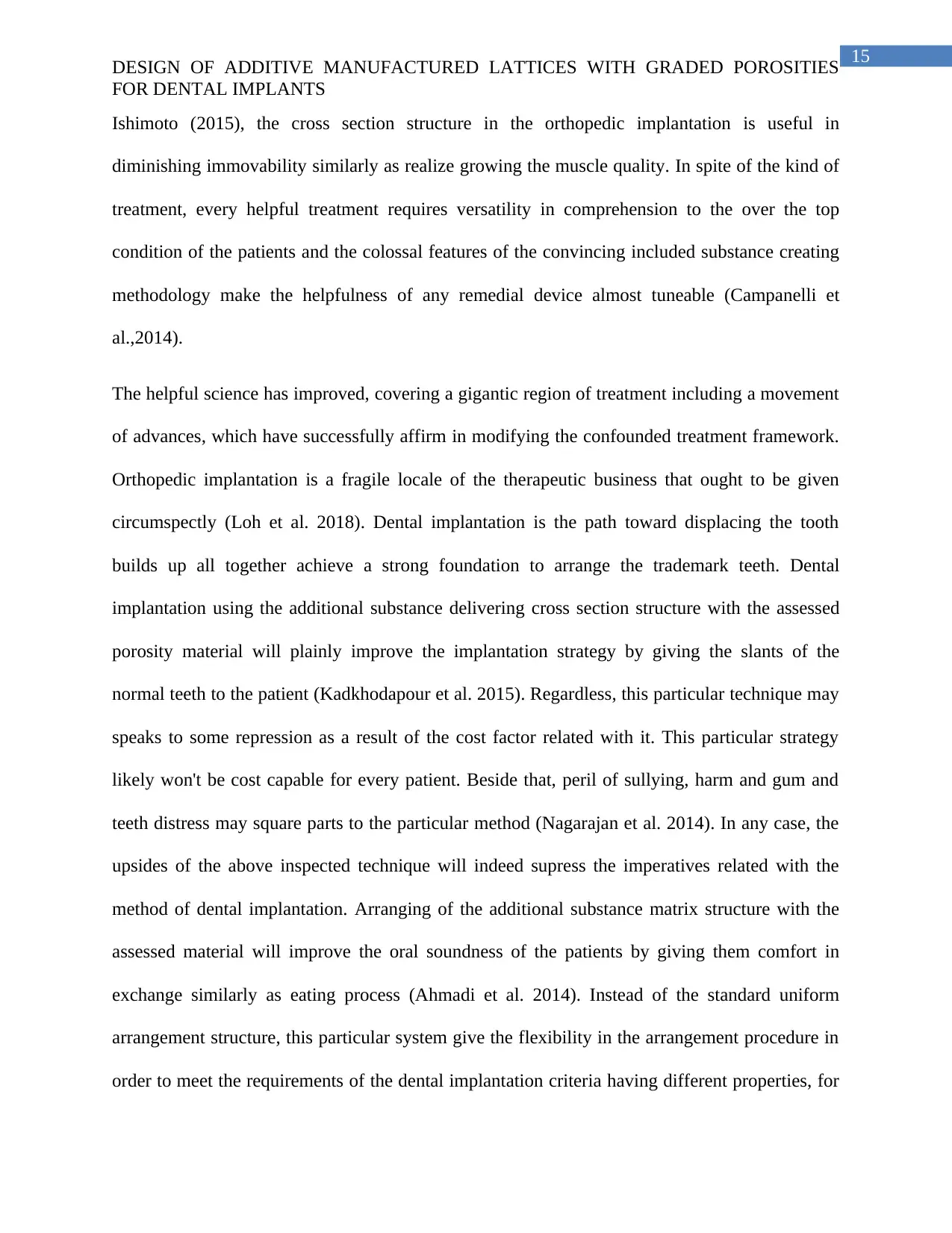
15
DESIGN OF ADDITIVE MANUFACTURED LATTICES WITH GRADED POROSITIES
FOR DENTAL IMPLANTS
Ishimoto (2015), the cross section structure in the orthopedic implantation is useful in
diminishing immovability similarly as realize growing the muscle quality. In spite of the kind of
treatment, every helpful treatment requires versatility in comprehension to the over the top
condition of the patients and the colossal features of the convincing included substance creating
methodology make the helpfulness of any remedial device almost tuneable (Campanelli et
al.,2014).
The helpful science has improved, covering a gigantic region of treatment including a movement
of advances, which have successfully affirm in modifying the confounded treatment framework.
Orthopedic implantation is a fragile locale of the therapeutic business that ought to be given
circumspectly (Loh et al. 2018). Dental implantation is the path toward displacing the tooth
builds up all together achieve a strong foundation to arrange the trademark teeth. Dental
implantation using the additional substance delivering cross section structure with the assessed
porosity material will plainly improve the implantation strategy by giving the slants of the
normal teeth to the patient (Kadkhodapour et al. 2015). Regardless, this particular technique may
speaks to some repression as a result of the cost factor related with it. This particular strategy
likely won't be cost capable for every patient. Beside that, peril of sullying, harm and gum and
teeth distress may square parts to the particular method (Nagarajan et al. 2014). In any case, the
upsides of the above inspected technique will indeed supress the imperatives related with the
method of dental implantation. Arranging of the additional substance matrix structure with the
assessed material will improve the oral soundness of the patients by giving them comfort in
exchange similarly as eating process (Ahmadi et al. 2014). Instead of the standard uniform
arrangement structure, this particular system give the flexibility in the arrangement procedure in
order to meet the requirements of the dental implantation criteria having different properties, for
DESIGN OF ADDITIVE MANUFACTURED LATTICES WITH GRADED POROSITIES
FOR DENTAL IMPLANTS
Ishimoto (2015), the cross section structure in the orthopedic implantation is useful in
diminishing immovability similarly as realize growing the muscle quality. In spite of the kind of
treatment, every helpful treatment requires versatility in comprehension to the over the top
condition of the patients and the colossal features of the convincing included substance creating
methodology make the helpfulness of any remedial device almost tuneable (Campanelli et
al.,2014).
The helpful science has improved, covering a gigantic region of treatment including a movement
of advances, which have successfully affirm in modifying the confounded treatment framework.
Orthopedic implantation is a fragile locale of the therapeutic business that ought to be given
circumspectly (Loh et al. 2018). Dental implantation is the path toward displacing the tooth
builds up all together achieve a strong foundation to arrange the trademark teeth. Dental
implantation using the additional substance delivering cross section structure with the assessed
porosity material will plainly improve the implantation strategy by giving the slants of the
normal teeth to the patient (Kadkhodapour et al. 2015). Regardless, this particular technique may
speaks to some repression as a result of the cost factor related with it. This particular strategy
likely won't be cost capable for every patient. Beside that, peril of sullying, harm and gum and
teeth distress may square parts to the particular method (Nagarajan et al. 2014). In any case, the
upsides of the above inspected technique will indeed supress the imperatives related with the
method of dental implantation. Arranging of the additional substance matrix structure with the
assessed material will improve the oral soundness of the patients by giving them comfort in
exchange similarly as eating process (Ahmadi et al. 2014). Instead of the standard uniform
arrangement structure, this particular system give the flexibility in the arrangement procedure in
order to meet the requirements of the dental implantation criteria having different properties, for
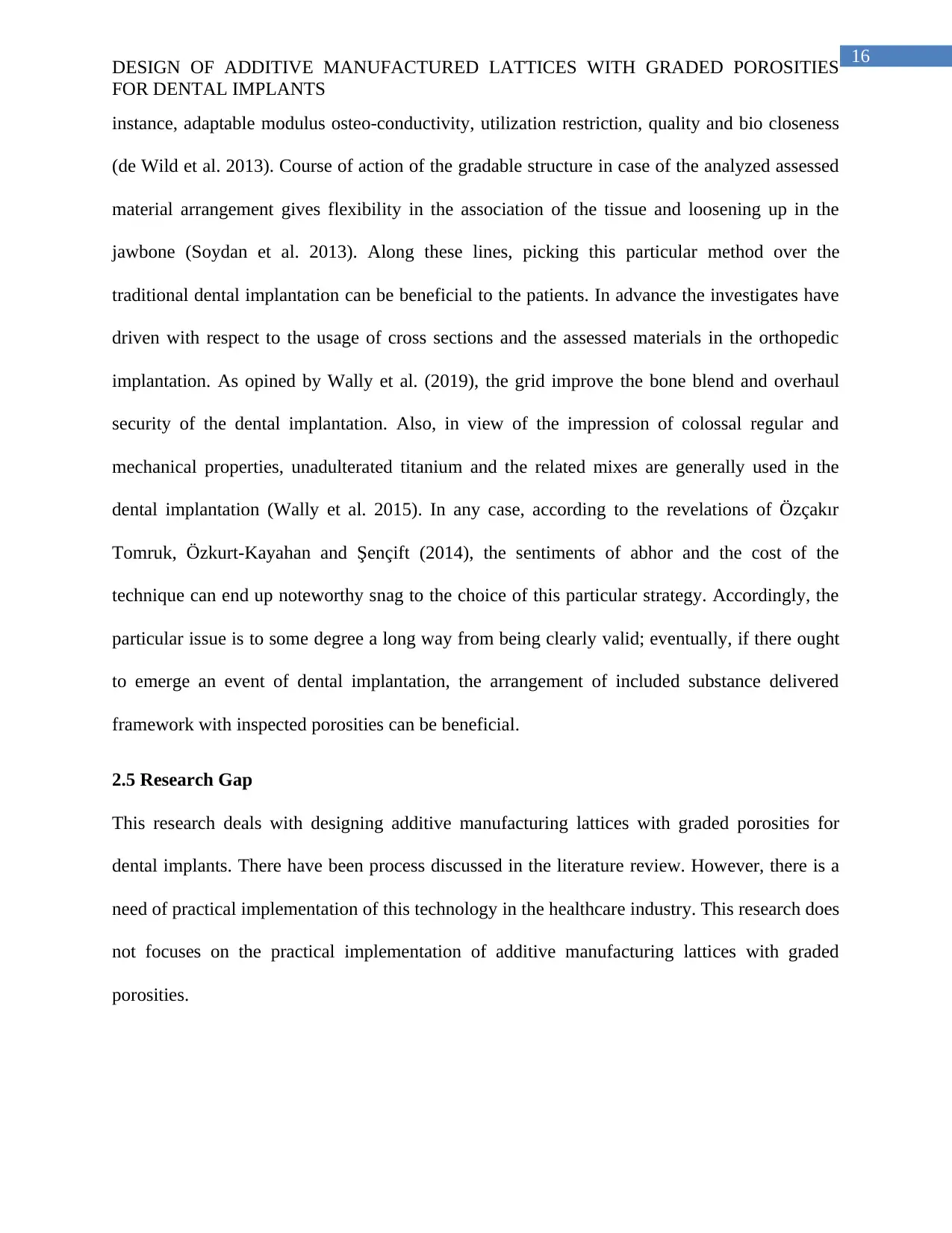
16
DESIGN OF ADDITIVE MANUFACTURED LATTICES WITH GRADED POROSITIES
FOR DENTAL IMPLANTS
instance, adaptable modulus osteo-conductivity, utilization restriction, quality and bio closeness
(de Wild et al. 2013). Course of action of the gradable structure in case of the analyzed assessed
material arrangement gives flexibility in the association of the tissue and loosening up in the
jawbone (Soydan et al. 2013). Along these lines, picking this particular method over the
traditional dental implantation can be beneficial to the patients. In advance the investigates have
driven with respect to the usage of cross sections and the assessed materials in the orthopedic
implantation. As opined by Wally et al. (2019), the grid improve the bone blend and overhaul
security of the dental implantation. Also, in view of the impression of colossal regular and
mechanical properties, unadulterated titanium and the related mixes are generally used in the
dental implantation (Wally et al. 2015). In any case, according to the revelations of Özçakır
Tomruk, Özkurt-Kayahan and Şençift (2014), the sentiments of abhor and the cost of the
technique can end up noteworthy snag to the choice of this particular strategy. Accordingly, the
particular issue is to some degree a long way from being clearly valid; eventually, if there ought
to emerge an event of dental implantation, the arrangement of included substance delivered
framework with inspected porosities can be beneficial.
2.5 Research Gap
This research deals with designing additive manufacturing lattices with graded porosities for
dental implants. There have been process discussed in the literature review. However, there is a
need of practical implementation of this technology in the healthcare industry. This research does
not focuses on the practical implementation of additive manufacturing lattices with graded
porosities.
DESIGN OF ADDITIVE MANUFACTURED LATTICES WITH GRADED POROSITIES
FOR DENTAL IMPLANTS
instance, adaptable modulus osteo-conductivity, utilization restriction, quality and bio closeness
(de Wild et al. 2013). Course of action of the gradable structure in case of the analyzed assessed
material arrangement gives flexibility in the association of the tissue and loosening up in the
jawbone (Soydan et al. 2013). Along these lines, picking this particular method over the
traditional dental implantation can be beneficial to the patients. In advance the investigates have
driven with respect to the usage of cross sections and the assessed materials in the orthopedic
implantation. As opined by Wally et al. (2019), the grid improve the bone blend and overhaul
security of the dental implantation. Also, in view of the impression of colossal regular and
mechanical properties, unadulterated titanium and the related mixes are generally used in the
dental implantation (Wally et al. 2015). In any case, according to the revelations of Özçakır
Tomruk, Özkurt-Kayahan and Şençift (2014), the sentiments of abhor and the cost of the
technique can end up noteworthy snag to the choice of this particular strategy. Accordingly, the
particular issue is to some degree a long way from being clearly valid; eventually, if there ought
to emerge an event of dental implantation, the arrangement of included substance delivered
framework with inspected porosities can be beneficial.
2.5 Research Gap
This research deals with designing additive manufacturing lattices with graded porosities for
dental implants. There have been process discussed in the literature review. However, there is a
need of practical implementation of this technology in the healthcare industry. This research does
not focuses on the practical implementation of additive manufacturing lattices with graded
porosities.
Secure Best Marks with AI Grader
Need help grading? Try our AI Grader for instant feedback on your assignments.
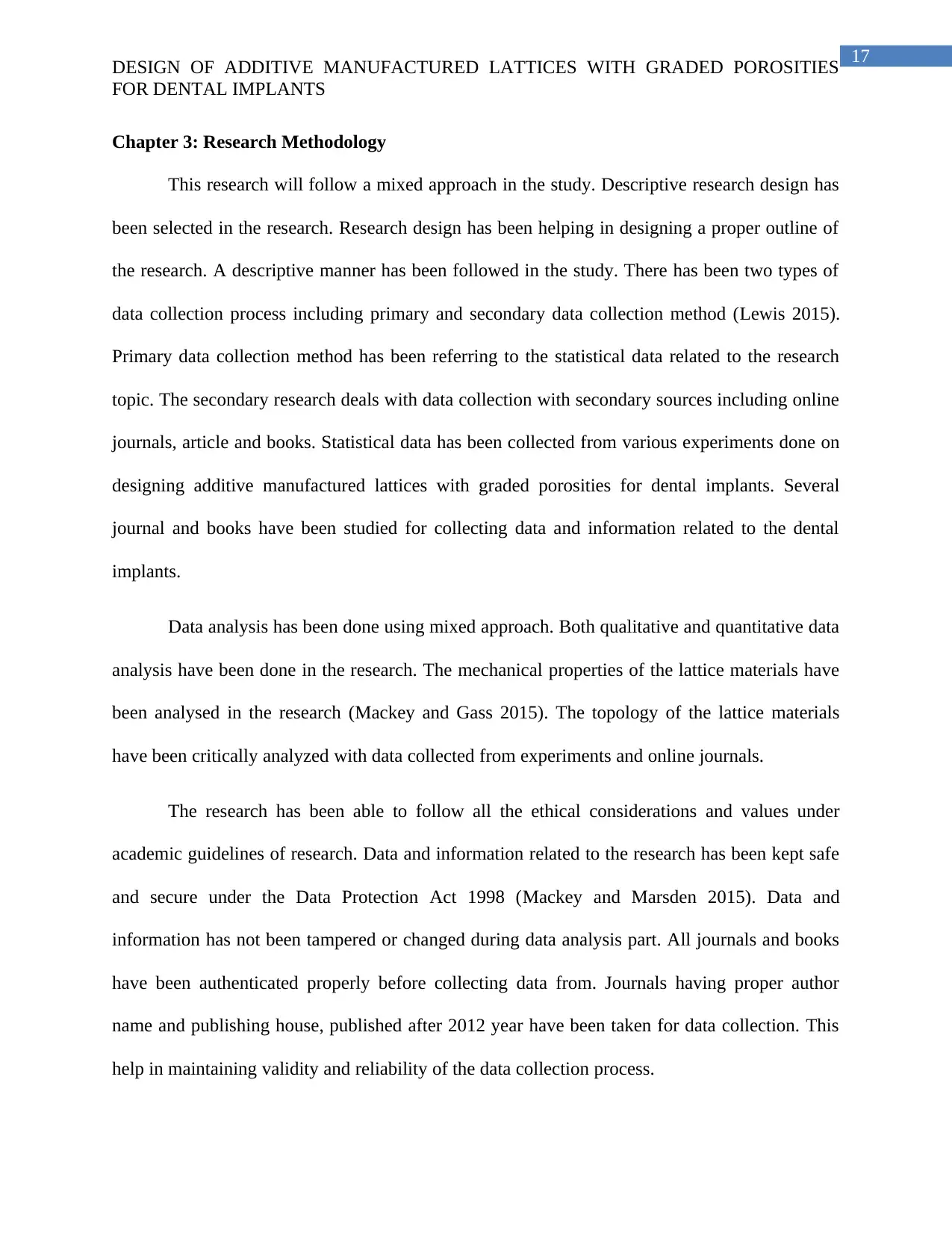
17
DESIGN OF ADDITIVE MANUFACTURED LATTICES WITH GRADED POROSITIES
FOR DENTAL IMPLANTS
Chapter 3: Research Methodology
This research will follow a mixed approach in the study. Descriptive research design has
been selected in the research. Research design has been helping in designing a proper outline of
the research. A descriptive manner has been followed in the study. There has been two types of
data collection process including primary and secondary data collection method (Lewis 2015).
Primary data collection method has been referring to the statistical data related to the research
topic. The secondary research deals with data collection with secondary sources including online
journals, article and books. Statistical data has been collected from various experiments done on
designing additive manufactured lattices with graded porosities for dental implants. Several
journal and books have been studied for collecting data and information related to the dental
implants.
Data analysis has been done using mixed approach. Both qualitative and quantitative data
analysis have been done in the research. The mechanical properties of the lattice materials have
been analysed in the research (Mackey and Gass 2015). The topology of the lattice materials
have been critically analyzed with data collected from experiments and online journals.
The research has been able to follow all the ethical considerations and values under
academic guidelines of research. Data and information related to the research has been kept safe
and secure under the Data Protection Act 1998 (Mackey and Marsden 2015). Data and
information has not been tampered or changed during data analysis part. All journals and books
have been authenticated properly before collecting data from. Journals having proper author
name and publishing house, published after 2012 year have been taken for data collection. This
help in maintaining validity and reliability of the data collection process.
DESIGN OF ADDITIVE MANUFACTURED LATTICES WITH GRADED POROSITIES
FOR DENTAL IMPLANTS
Chapter 3: Research Methodology
This research will follow a mixed approach in the study. Descriptive research design has
been selected in the research. Research design has been helping in designing a proper outline of
the research. A descriptive manner has been followed in the study. There has been two types of
data collection process including primary and secondary data collection method (Lewis 2015).
Primary data collection method has been referring to the statistical data related to the research
topic. The secondary research deals with data collection with secondary sources including online
journals, article and books. Statistical data has been collected from various experiments done on
designing additive manufactured lattices with graded porosities for dental implants. Several
journal and books have been studied for collecting data and information related to the dental
implants.
Data analysis has been done using mixed approach. Both qualitative and quantitative data
analysis have been done in the research. The mechanical properties of the lattice materials have
been analysed in the research (Mackey and Gass 2015). The topology of the lattice materials
have been critically analyzed with data collected from experiments and online journals.
The research has been able to follow all the ethical considerations and values under
academic guidelines of research. Data and information related to the research has been kept safe
and secure under the Data Protection Act 1998 (Mackey and Marsden 2015). Data and
information has not been tampered or changed during data analysis part. All journals and books
have been authenticated properly before collecting data from. Journals having proper author
name and publishing house, published after 2012 year have been taken for data collection. This
help in maintaining validity and reliability of the data collection process.
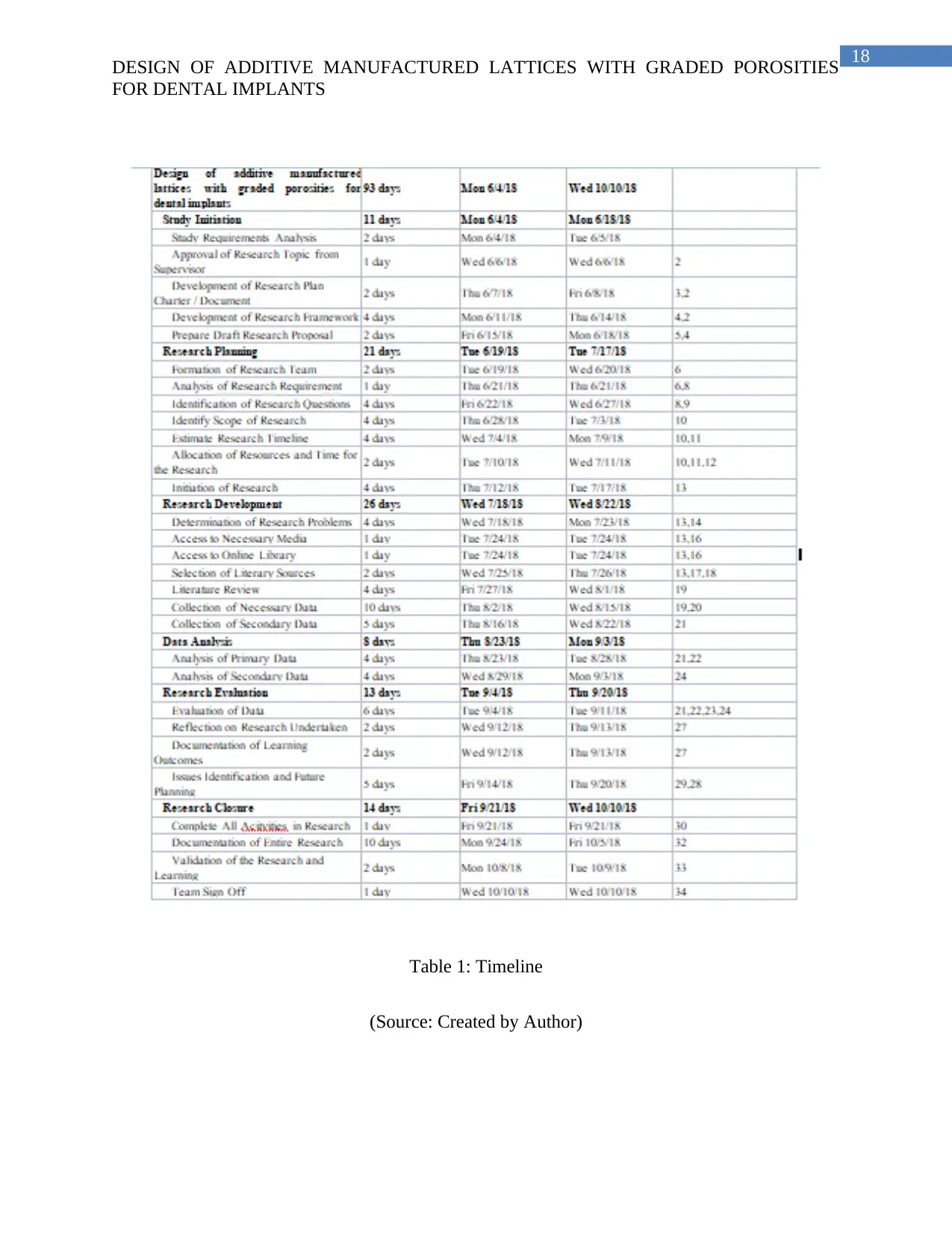
18
DESIGN OF ADDITIVE MANUFACTURED LATTICES WITH GRADED POROSITIES
FOR DENTAL IMPLANTS
Table 1: Timeline
(Source: Created by Author)
DESIGN OF ADDITIVE MANUFACTURED LATTICES WITH GRADED POROSITIES
FOR DENTAL IMPLANTS
Table 1: Timeline
(Source: Created by Author)
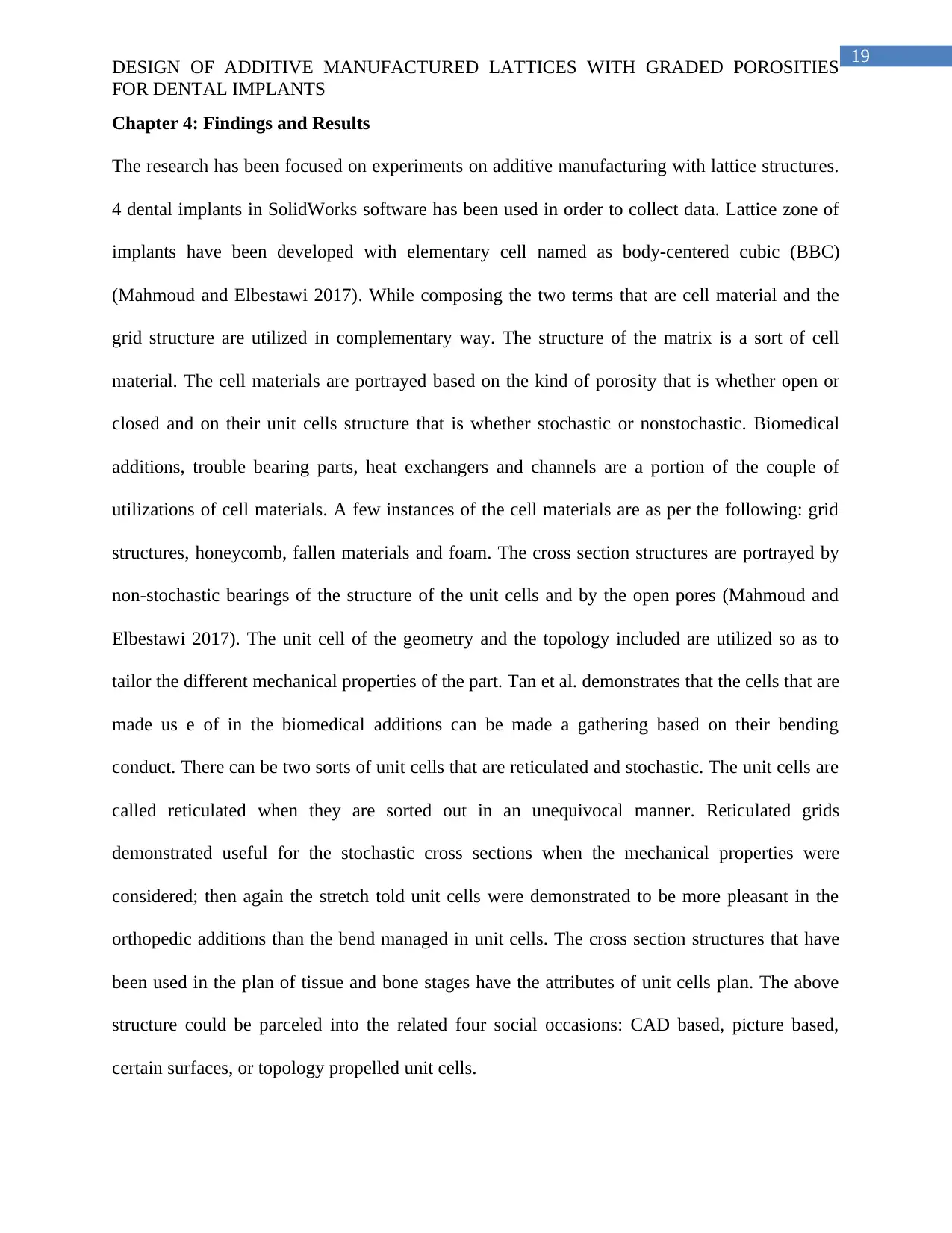
19
DESIGN OF ADDITIVE MANUFACTURED LATTICES WITH GRADED POROSITIES
FOR DENTAL IMPLANTS
Chapter 4: Findings and Results
The research has been focused on experiments on additive manufacturing with lattice structures.
4 dental implants in SolidWorks software has been used in order to collect data. Lattice zone of
implants have been developed with elementary cell named as body-centered cubic (BBC)
(Mahmoud and Elbestawi 2017). While composing the two terms that are cell material and the
grid structure are utilized in complementary way. The structure of the matrix is a sort of cell
material. The cell materials are portrayed based on the kind of porosity that is whether open or
closed and on their unit cells structure that is whether stochastic or nonstochastic. Biomedical
additions, trouble bearing parts, heat exchangers and channels are a portion of the couple of
utilizations of cell materials. A few instances of the cell materials are as per the following: grid
structures, honeycomb, fallen materials and foam. The cross section structures are portrayed by
non-stochastic bearings of the structure of the unit cells and by the open pores (Mahmoud and
Elbestawi 2017). The unit cell of the geometry and the topology included are utilized so as to
tailor the different mechanical properties of the part. Tan et al. demonstrates that the cells that are
made us e of in the biomedical additions can be made a gathering based on their bending
conduct. There can be two sorts of unit cells that are reticulated and stochastic. The unit cells are
called reticulated when they are sorted out in an unequivocal manner. Reticulated grids
demonstrated useful for the stochastic cross sections when the mechanical properties were
considered; then again the stretch told unit cells were demonstrated to be more pleasant in the
orthopedic additions than the bend managed in unit cells. The cross section structures that have
been used in the plan of tissue and bone stages have the attributes of unit cells plan. The above
structure could be parceled into the related four social occasions: CAD based, picture based,
certain surfaces, or topology propelled unit cells.
DESIGN OF ADDITIVE MANUFACTURED LATTICES WITH GRADED POROSITIES
FOR DENTAL IMPLANTS
Chapter 4: Findings and Results
The research has been focused on experiments on additive manufacturing with lattice structures.
4 dental implants in SolidWorks software has been used in order to collect data. Lattice zone of
implants have been developed with elementary cell named as body-centered cubic (BBC)
(Mahmoud and Elbestawi 2017). While composing the two terms that are cell material and the
grid structure are utilized in complementary way. The structure of the matrix is a sort of cell
material. The cell materials are portrayed based on the kind of porosity that is whether open or
closed and on their unit cells structure that is whether stochastic or nonstochastic. Biomedical
additions, trouble bearing parts, heat exchangers and channels are a portion of the couple of
utilizations of cell materials. A few instances of the cell materials are as per the following: grid
structures, honeycomb, fallen materials and foam. The cross section structures are portrayed by
non-stochastic bearings of the structure of the unit cells and by the open pores (Mahmoud and
Elbestawi 2017). The unit cell of the geometry and the topology included are utilized so as to
tailor the different mechanical properties of the part. Tan et al. demonstrates that the cells that are
made us e of in the biomedical additions can be made a gathering based on their bending
conduct. There can be two sorts of unit cells that are reticulated and stochastic. The unit cells are
called reticulated when they are sorted out in an unequivocal manner. Reticulated grids
demonstrated useful for the stochastic cross sections when the mechanical properties were
considered; then again the stretch told unit cells were demonstrated to be more pleasant in the
orthopedic additions than the bend managed in unit cells. The cross section structures that have
been used in the plan of tissue and bone stages have the attributes of unit cells plan. The above
structure could be parceled into the related four social occasions: CAD based, picture based,
certain surfaces, or topology propelled unit cells.
Paraphrase This Document
Need a fresh take? Get an instant paraphrase of this document with our AI Paraphraser
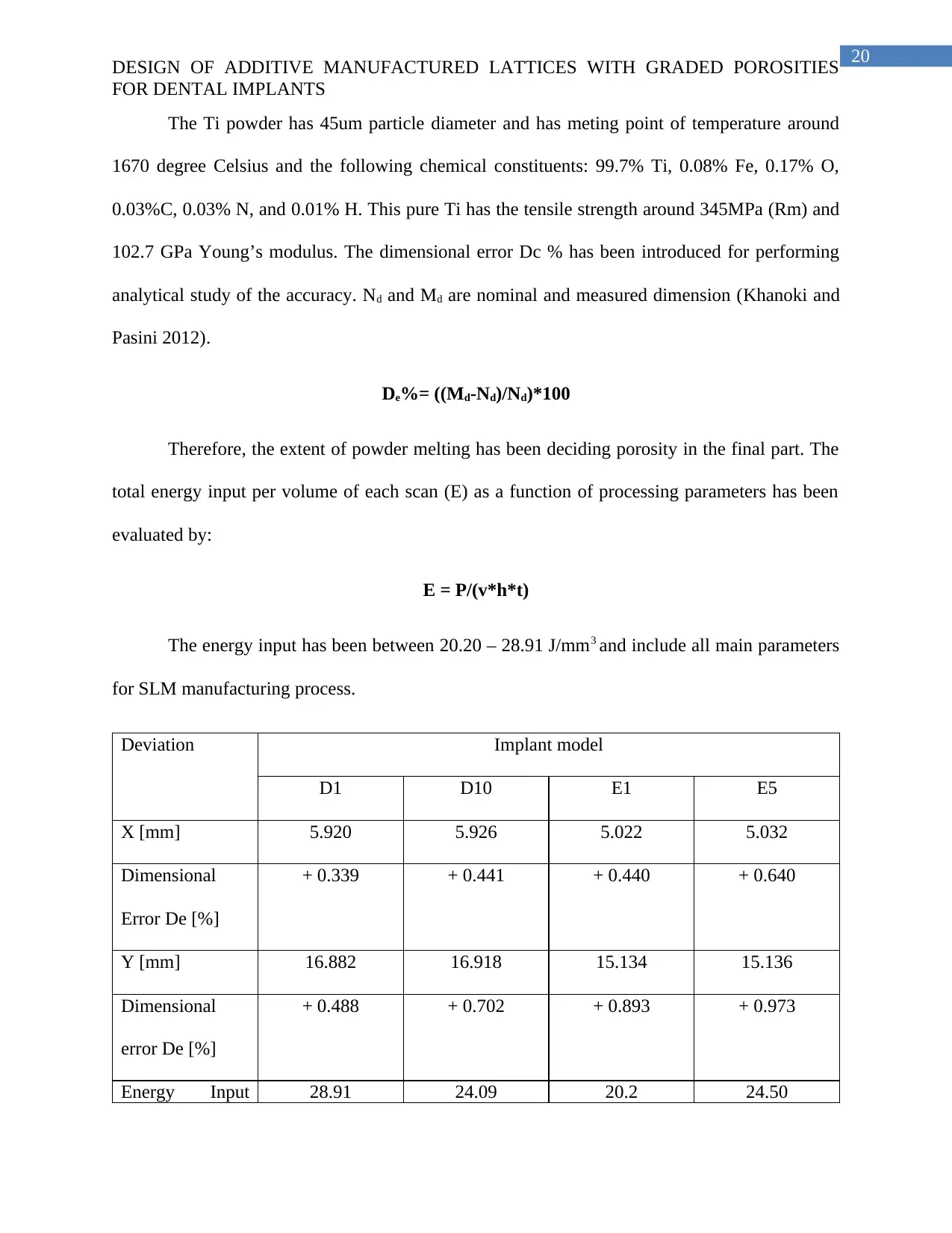
20
DESIGN OF ADDITIVE MANUFACTURED LATTICES WITH GRADED POROSITIES
FOR DENTAL IMPLANTS
The Ti powder has 45um particle diameter and has meting point of temperature around
1670 degree Celsius and the following chemical constituents: 99.7% Ti, 0.08% Fe, 0.17% O,
0.03%C, 0.03% N, and 0.01% H. This pure Ti has the tensile strength around 345MPa (Rm) and
102.7 GPa Young’s modulus. The dimensional error Dc % has been introduced for performing
analytical study of the accuracy. Nd and Md are nominal and measured dimension (Khanoki and
Pasini 2012).
De%= ((Md-Nd)/Nd)*100
Therefore, the extent of powder melting has been deciding porosity in the final part. The
total energy input per volume of each scan (E) as a function of processing parameters has been
evaluated by:
E = P/(v*h*t)
The energy input has been between 20.20 – 28.91 J/mm3 and include all main parameters
for SLM manufacturing process.
Deviation Implant model
D1 D10 E1 E5
X [mm] 5.920 5.926 5.022 5.032
Dimensional
Error De [%]
+ 0.339 + 0.441 + 0.440 + 0.640
Y [mm] 16.882 16.918 15.134 15.136
Dimensional
error De [%]
+ 0.488 + 0.702 + 0.893 + 0.973
Energy Input 28.91 24.09 20.2 24.50
DESIGN OF ADDITIVE MANUFACTURED LATTICES WITH GRADED POROSITIES
FOR DENTAL IMPLANTS
The Ti powder has 45um particle diameter and has meting point of temperature around
1670 degree Celsius and the following chemical constituents: 99.7% Ti, 0.08% Fe, 0.17% O,
0.03%C, 0.03% N, and 0.01% H. This pure Ti has the tensile strength around 345MPa (Rm) and
102.7 GPa Young’s modulus. The dimensional error Dc % has been introduced for performing
analytical study of the accuracy. Nd and Md are nominal and measured dimension (Khanoki and
Pasini 2012).
De%= ((Md-Nd)/Nd)*100
Therefore, the extent of powder melting has been deciding porosity in the final part. The
total energy input per volume of each scan (E) as a function of processing parameters has been
evaluated by:
E = P/(v*h*t)
The energy input has been between 20.20 – 28.91 J/mm3 and include all main parameters
for SLM manufacturing process.
Deviation Implant model
D1 D10 E1 E5
X [mm] 5.920 5.926 5.022 5.032
Dimensional
Error De [%]
+ 0.339 + 0.441 + 0.440 + 0.640
Y [mm] 16.882 16.918 15.134 15.136
Dimensional
error De [%]
+ 0.488 + 0.702 + 0.893 + 0.973
Energy Input 28.91 24.09 20.2 24.50
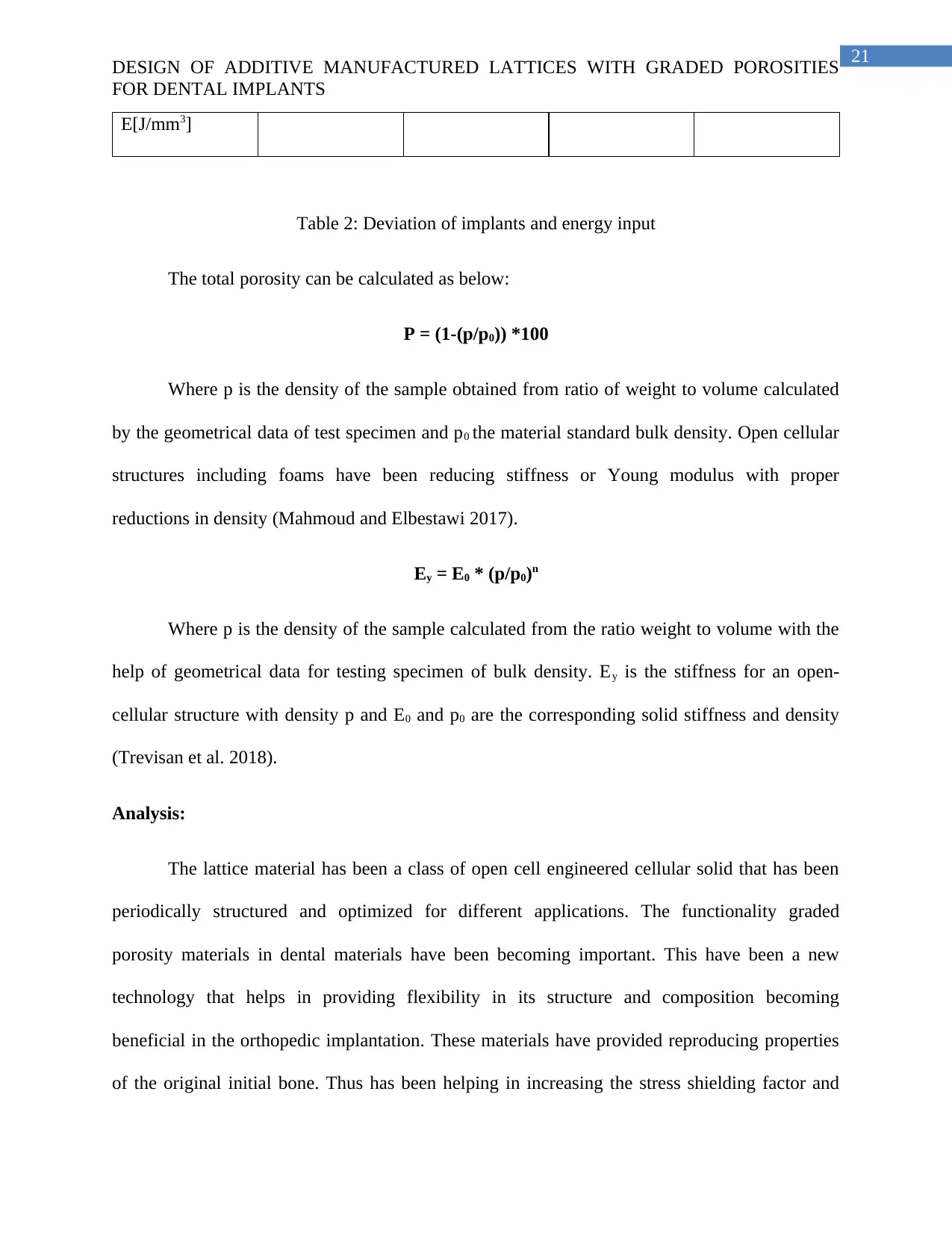
21
DESIGN OF ADDITIVE MANUFACTURED LATTICES WITH GRADED POROSITIES
FOR DENTAL IMPLANTS
E[J/mm3]
Table 2: Deviation of implants and energy input
The total porosity can be calculated as below:
P = (1-(p/p0)) *100
Where p is the density of the sample obtained from ratio of weight to volume calculated
by the geometrical data of test specimen and p0 the material standard bulk density. Open cellular
structures including foams have been reducing stiffness or Young modulus with proper
reductions in density (Mahmoud and Elbestawi 2017).
Ey = E0 * (p/p0)n
Where p is the density of the sample calculated from the ratio weight to volume with the
help of geometrical data for testing specimen of bulk density. Ey is the stiffness for an open-
cellular structure with density p and E0 and p0 are the corresponding solid stiffness and density
(Trevisan et al. 2018).
Analysis:
The lattice material has been a class of open cell engineered cellular solid that has been
periodically structured and optimized for different applications. The functionality graded
porosity materials in dental materials have been becoming important. This have been a new
technology that helps in providing flexibility in its structure and composition becoming
beneficial in the orthopedic implantation. These materials have provided reproducing properties
of the original initial bone. Thus has been helping in increasing the stress shielding factor and
DESIGN OF ADDITIVE MANUFACTURED LATTICES WITH GRADED POROSITIES
FOR DENTAL IMPLANTS
E[J/mm3]
Table 2: Deviation of implants and energy input
The total porosity can be calculated as below:
P = (1-(p/p0)) *100
Where p is the density of the sample obtained from ratio of weight to volume calculated
by the geometrical data of test specimen and p0 the material standard bulk density. Open cellular
structures including foams have been reducing stiffness or Young modulus with proper
reductions in density (Mahmoud and Elbestawi 2017).
Ey = E0 * (p/p0)n
Where p is the density of the sample calculated from the ratio weight to volume with the
help of geometrical data for testing specimen of bulk density. Ey is the stiffness for an open-
cellular structure with density p and E0 and p0 are the corresponding solid stiffness and density
(Trevisan et al. 2018).
Analysis:
The lattice material has been a class of open cell engineered cellular solid that has been
periodically structured and optimized for different applications. The functionality graded
porosity materials in dental materials have been becoming important. This have been a new
technology that helps in providing flexibility in its structure and composition becoming
beneficial in the orthopedic implantation. These materials have provided reproducing properties
of the original initial bone. Thus has been helping in increasing the stress shielding factor and
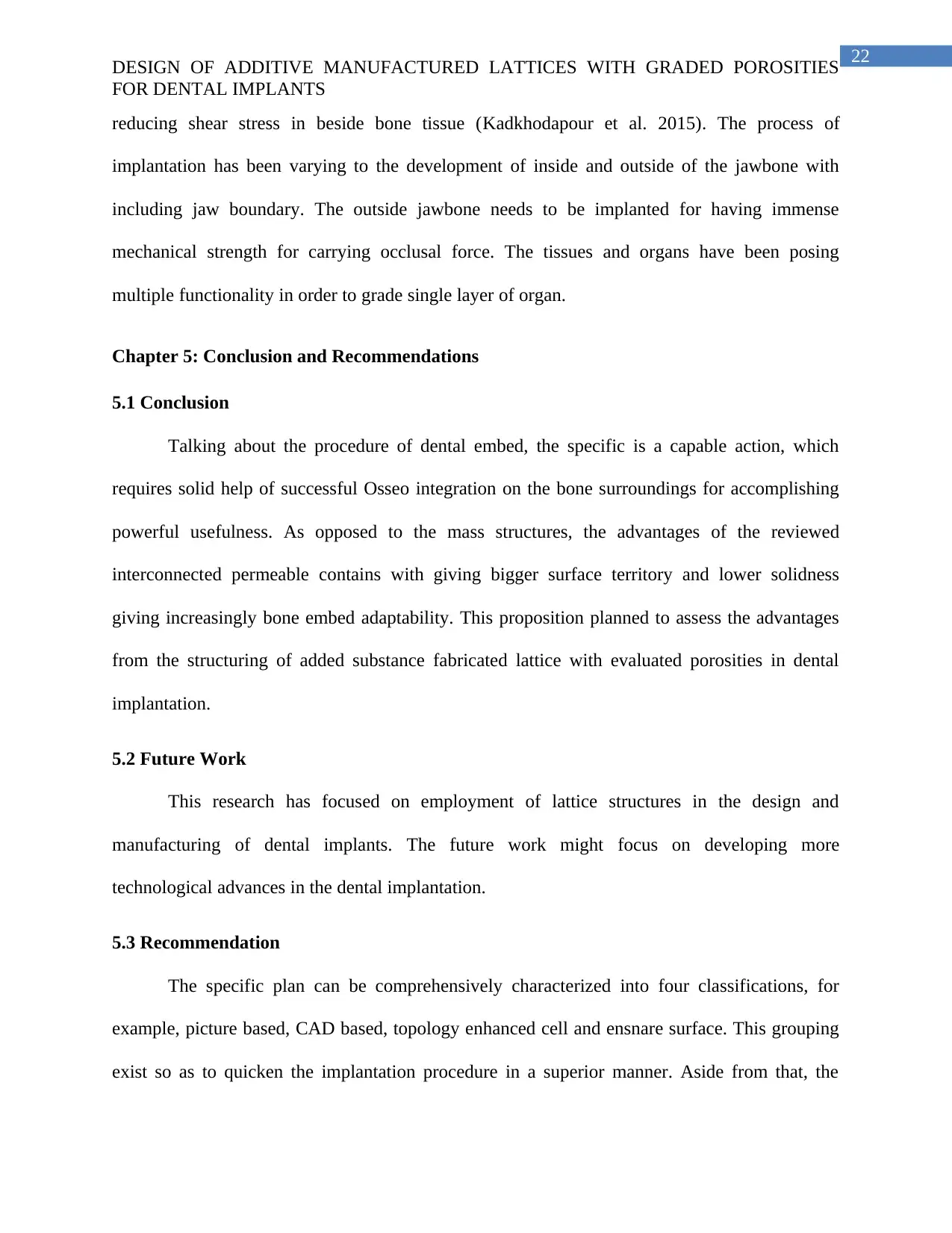
22
DESIGN OF ADDITIVE MANUFACTURED LATTICES WITH GRADED POROSITIES
FOR DENTAL IMPLANTS
reducing shear stress in beside bone tissue (Kadkhodapour et al. 2015). The process of
implantation has been varying to the development of inside and outside of the jawbone with
including jaw boundary. The outside jawbone needs to be implanted for having immense
mechanical strength for carrying occlusal force. The tissues and organs have been posing
multiple functionality in order to grade single layer of organ.
Chapter 5: Conclusion and Recommendations
5.1 Conclusion
Talking about the procedure of dental embed, the specific is a capable action, which
requires solid help of successful Osseo integration on the bone surroundings for accomplishing
powerful usefulness. As opposed to the mass structures, the advantages of the reviewed
interconnected permeable contains with giving bigger surface territory and lower solidness
giving increasingly bone embed adaptability. This proposition planned to assess the advantages
from the structuring of added substance fabricated lattice with evaluated porosities in dental
implantation.
5.2 Future Work
This research has focused on employment of lattice structures in the design and
manufacturing of dental implants. The future work might focus on developing more
technological advances in the dental implantation.
5.3 Recommendation
The specific plan can be comprehensively characterized into four classifications, for
example, picture based, CAD based, topology enhanced cell and ensnare surface. This grouping
exist so as to quicken the implantation procedure in a superior manner. Aside from that, the
DESIGN OF ADDITIVE MANUFACTURED LATTICES WITH GRADED POROSITIES
FOR DENTAL IMPLANTS
reducing shear stress in beside bone tissue (Kadkhodapour et al. 2015). The process of
implantation has been varying to the development of inside and outside of the jawbone with
including jaw boundary. The outside jawbone needs to be implanted for having immense
mechanical strength for carrying occlusal force. The tissues and organs have been posing
multiple functionality in order to grade single layer of organ.
Chapter 5: Conclusion and Recommendations
5.1 Conclusion
Talking about the procedure of dental embed, the specific is a capable action, which
requires solid help of successful Osseo integration on the bone surroundings for accomplishing
powerful usefulness. As opposed to the mass structures, the advantages of the reviewed
interconnected permeable contains with giving bigger surface territory and lower solidness
giving increasingly bone embed adaptability. This proposition planned to assess the advantages
from the structuring of added substance fabricated lattice with evaluated porosities in dental
implantation.
5.2 Future Work
This research has focused on employment of lattice structures in the design and
manufacturing of dental implants. The future work might focus on developing more
technological advances in the dental implantation.
5.3 Recommendation
The specific plan can be comprehensively characterized into four classifications, for
example, picture based, CAD based, topology enhanced cell and ensnare surface. This grouping
exist so as to quicken the implantation procedure in a superior manner. Aside from that, the
Secure Best Marks with AI Grader
Need help grading? Try our AI Grader for instant feedback on your assignments.
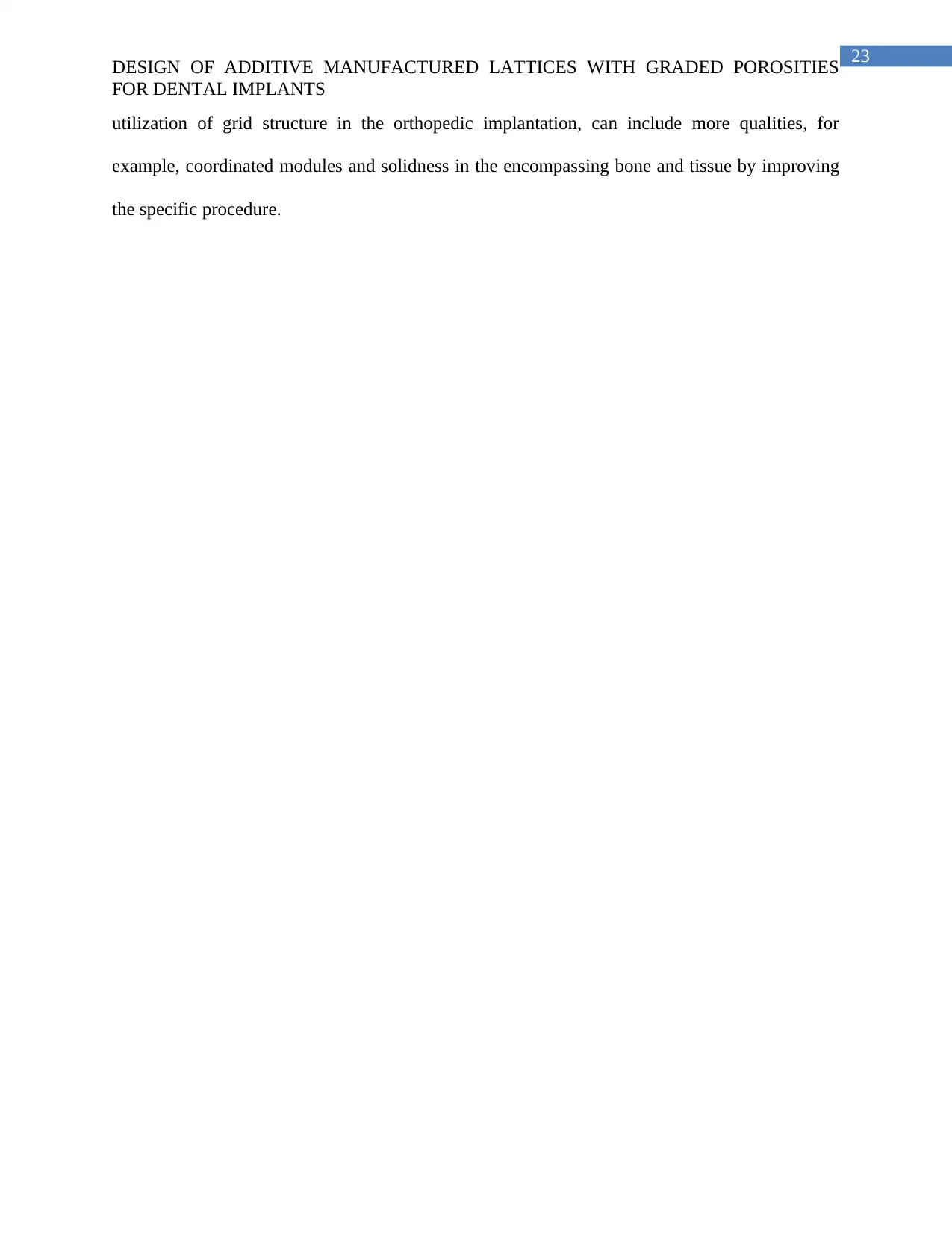
23
DESIGN OF ADDITIVE MANUFACTURED LATTICES WITH GRADED POROSITIES
FOR DENTAL IMPLANTS
utilization of grid structure in the orthopedic implantation, can include more qualities, for
example, coordinated modules and solidness in the encompassing bone and tissue by improving
the specific procedure.
DESIGN OF ADDITIVE MANUFACTURED LATTICES WITH GRADED POROSITIES
FOR DENTAL IMPLANTS
utilization of grid structure in the orthopedic implantation, can include more qualities, for
example, coordinated modules and solidness in the encompassing bone and tissue by improving
the specific procedure.
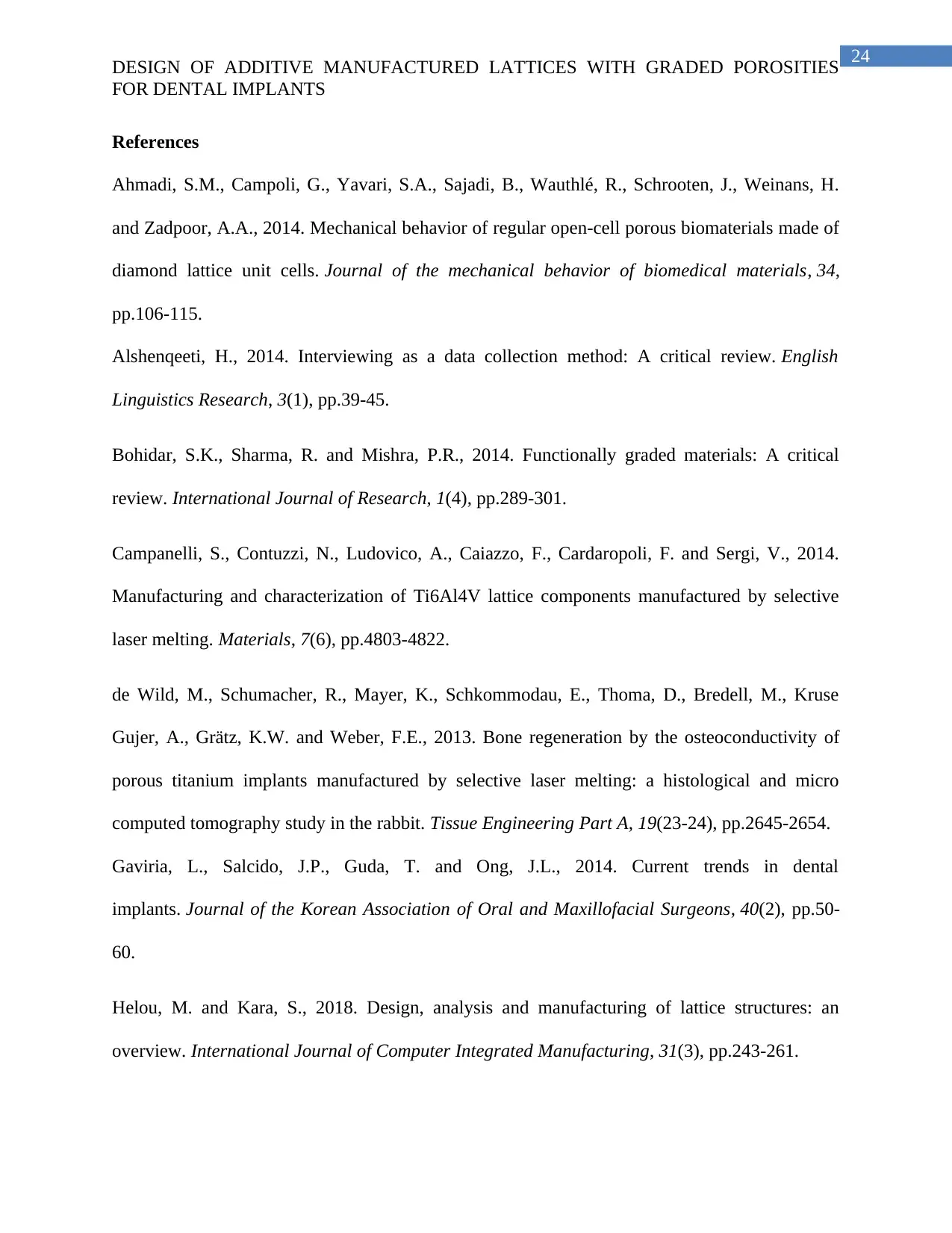
24
DESIGN OF ADDITIVE MANUFACTURED LATTICES WITH GRADED POROSITIES
FOR DENTAL IMPLANTS
References
Ahmadi, S.M., Campoli, G., Yavari, S.A., Sajadi, B., Wauthlé, R., Schrooten, J., Weinans, H.
and Zadpoor, A.A., 2014. Mechanical behavior of regular open-cell porous biomaterials made of
diamond lattice unit cells. Journal of the mechanical behavior of biomedical materials, 34,
pp.106-115.
Alshenqeeti, H., 2014. Interviewing as a data collection method: A critical review. English
Linguistics Research, 3(1), pp.39-45.
Bohidar, S.K., Sharma, R. and Mishra, P.R., 2014. Functionally graded materials: A critical
review. International Journal of Research, 1(4), pp.289-301.
Campanelli, S., Contuzzi, N., Ludovico, A., Caiazzo, F., Cardaropoli, F. and Sergi, V., 2014.
Manufacturing and characterization of Ti6Al4V lattice components manufactured by selective
laser melting. Materials, 7(6), pp.4803-4822.
de Wild, M., Schumacher, R., Mayer, K., Schkommodau, E., Thoma, D., Bredell, M., Kruse
Gujer, A., Grätz, K.W. and Weber, F.E., 2013. Bone regeneration by the osteoconductivity of
porous titanium implants manufactured by selective laser melting: a histological and micro
computed tomography study in the rabbit. Tissue Engineering Part A, 19(23-24), pp.2645-2654.
Gaviria, L., Salcido, J.P., Guda, T. and Ong, J.L., 2014. Current trends in dental
implants. Journal of the Korean Association of Oral and Maxillofacial Surgeons, 40(2), pp.50-
60.
Helou, M. and Kara, S., 2018. Design, analysis and manufacturing of lattice structures: an
overview. International Journal of Computer Integrated Manufacturing, 31(3), pp.243-261.
DESIGN OF ADDITIVE MANUFACTURED LATTICES WITH GRADED POROSITIES
FOR DENTAL IMPLANTS
References
Ahmadi, S.M., Campoli, G., Yavari, S.A., Sajadi, B., Wauthlé, R., Schrooten, J., Weinans, H.
and Zadpoor, A.A., 2014. Mechanical behavior of regular open-cell porous biomaterials made of
diamond lattice unit cells. Journal of the mechanical behavior of biomedical materials, 34,
pp.106-115.
Alshenqeeti, H., 2014. Interviewing as a data collection method: A critical review. English
Linguistics Research, 3(1), pp.39-45.
Bohidar, S.K., Sharma, R. and Mishra, P.R., 2014. Functionally graded materials: A critical
review. International Journal of Research, 1(4), pp.289-301.
Campanelli, S., Contuzzi, N., Ludovico, A., Caiazzo, F., Cardaropoli, F. and Sergi, V., 2014.
Manufacturing and characterization of Ti6Al4V lattice components manufactured by selective
laser melting. Materials, 7(6), pp.4803-4822.
de Wild, M., Schumacher, R., Mayer, K., Schkommodau, E., Thoma, D., Bredell, M., Kruse
Gujer, A., Grätz, K.W. and Weber, F.E., 2013. Bone regeneration by the osteoconductivity of
porous titanium implants manufactured by selective laser melting: a histological and micro
computed tomography study in the rabbit. Tissue Engineering Part A, 19(23-24), pp.2645-2654.
Gaviria, L., Salcido, J.P., Guda, T. and Ong, J.L., 2014. Current trends in dental
implants. Journal of the Korean Association of Oral and Maxillofacial Surgeons, 40(2), pp.50-
60.
Helou, M. and Kara, S., 2018. Design, analysis and manufacturing of lattice structures: an
overview. International Journal of Computer Integrated Manufacturing, 31(3), pp.243-261.
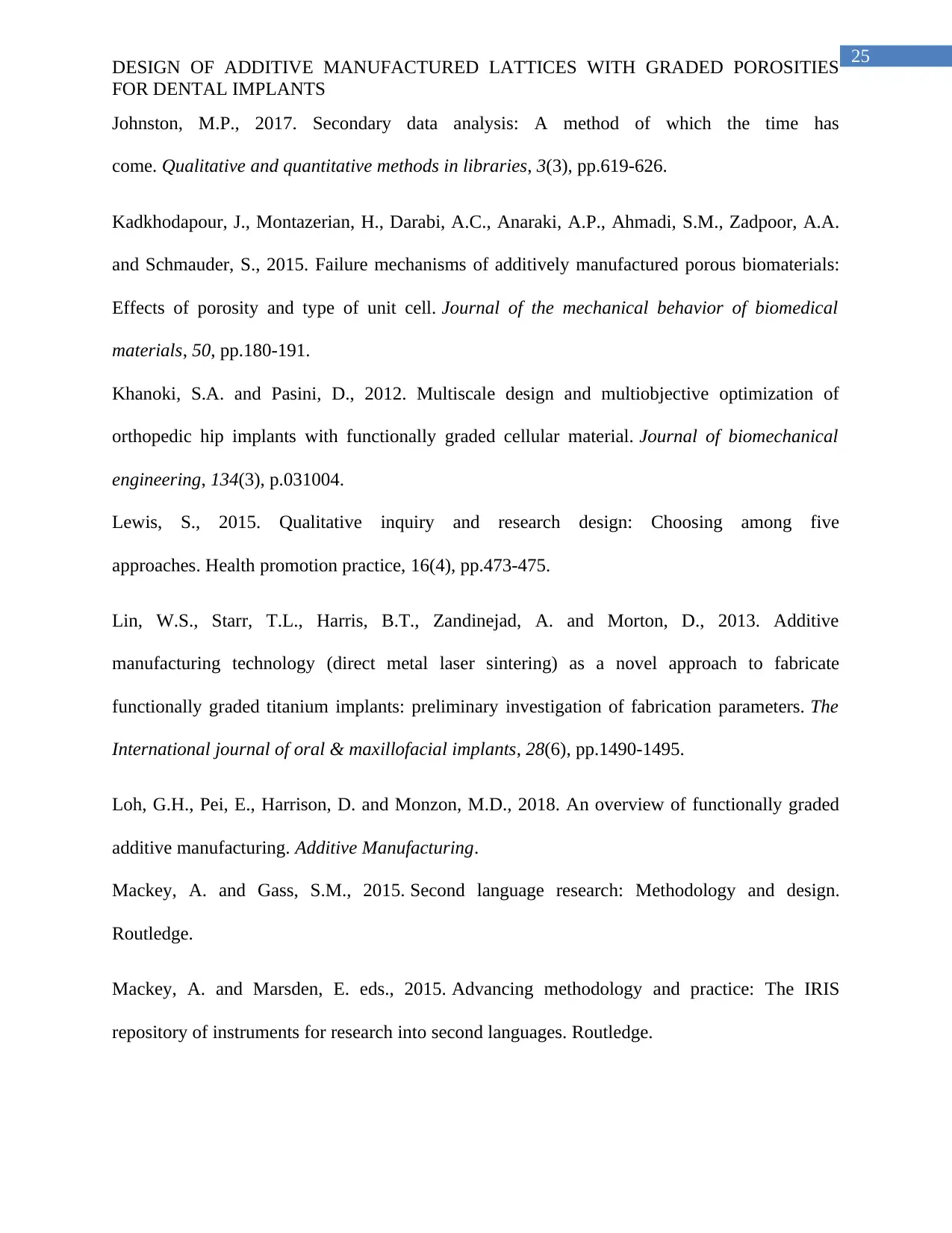
25
DESIGN OF ADDITIVE MANUFACTURED LATTICES WITH GRADED POROSITIES
FOR DENTAL IMPLANTS
Johnston, M.P., 2017. Secondary data analysis: A method of which the time has
come. Qualitative and quantitative methods in libraries, 3(3), pp.619-626.
Kadkhodapour, J., Montazerian, H., Darabi, A.C., Anaraki, A.P., Ahmadi, S.M., Zadpoor, A.A.
and Schmauder, S., 2015. Failure mechanisms of additively manufactured porous biomaterials:
Effects of porosity and type of unit cell. Journal of the mechanical behavior of biomedical
materials, 50, pp.180-191.
Khanoki, S.A. and Pasini, D., 2012. Multiscale design and multiobjective optimization of
orthopedic hip implants with functionally graded cellular material. Journal of biomechanical
engineering, 134(3), p.031004.
Lewis, S., 2015. Qualitative inquiry and research design: Choosing among five
approaches. Health promotion practice, 16(4), pp.473-475.
Lin, W.S., Starr, T.L., Harris, B.T., Zandinejad, A. and Morton, D., 2013. Additive
manufacturing technology (direct metal laser sintering) as a novel approach to fabricate
functionally graded titanium implants: preliminary investigation of fabrication parameters. The
International journal of oral & maxillofacial implants, 28(6), pp.1490-1495.
Loh, G.H., Pei, E., Harrison, D. and Monzon, M.D., 2018. An overview of functionally graded
additive manufacturing. Additive Manufacturing.
Mackey, A. and Gass, S.M., 2015. Second language research: Methodology and design.
Routledge.
Mackey, A. and Marsden, E. eds., 2015. Advancing methodology and practice: The IRIS
repository of instruments for research into second languages. Routledge.
DESIGN OF ADDITIVE MANUFACTURED LATTICES WITH GRADED POROSITIES
FOR DENTAL IMPLANTS
Johnston, M.P., 2017. Secondary data analysis: A method of which the time has
come. Qualitative and quantitative methods in libraries, 3(3), pp.619-626.
Kadkhodapour, J., Montazerian, H., Darabi, A.C., Anaraki, A.P., Ahmadi, S.M., Zadpoor, A.A.
and Schmauder, S., 2015. Failure mechanisms of additively manufactured porous biomaterials:
Effects of porosity and type of unit cell. Journal of the mechanical behavior of biomedical
materials, 50, pp.180-191.
Khanoki, S.A. and Pasini, D., 2012. Multiscale design and multiobjective optimization of
orthopedic hip implants with functionally graded cellular material. Journal of biomechanical
engineering, 134(3), p.031004.
Lewis, S., 2015. Qualitative inquiry and research design: Choosing among five
approaches. Health promotion practice, 16(4), pp.473-475.
Lin, W.S., Starr, T.L., Harris, B.T., Zandinejad, A. and Morton, D., 2013. Additive
manufacturing technology (direct metal laser sintering) as a novel approach to fabricate
functionally graded titanium implants: preliminary investigation of fabrication parameters. The
International journal of oral & maxillofacial implants, 28(6), pp.1490-1495.
Loh, G.H., Pei, E., Harrison, D. and Monzon, M.D., 2018. An overview of functionally graded
additive manufacturing. Additive Manufacturing.
Mackey, A. and Gass, S.M., 2015. Second language research: Methodology and design.
Routledge.
Mackey, A. and Marsden, E. eds., 2015. Advancing methodology and practice: The IRIS
repository of instruments for research into second languages. Routledge.
Paraphrase This Document
Need a fresh take? Get an instant paraphrase of this document with our AI Paraphraser
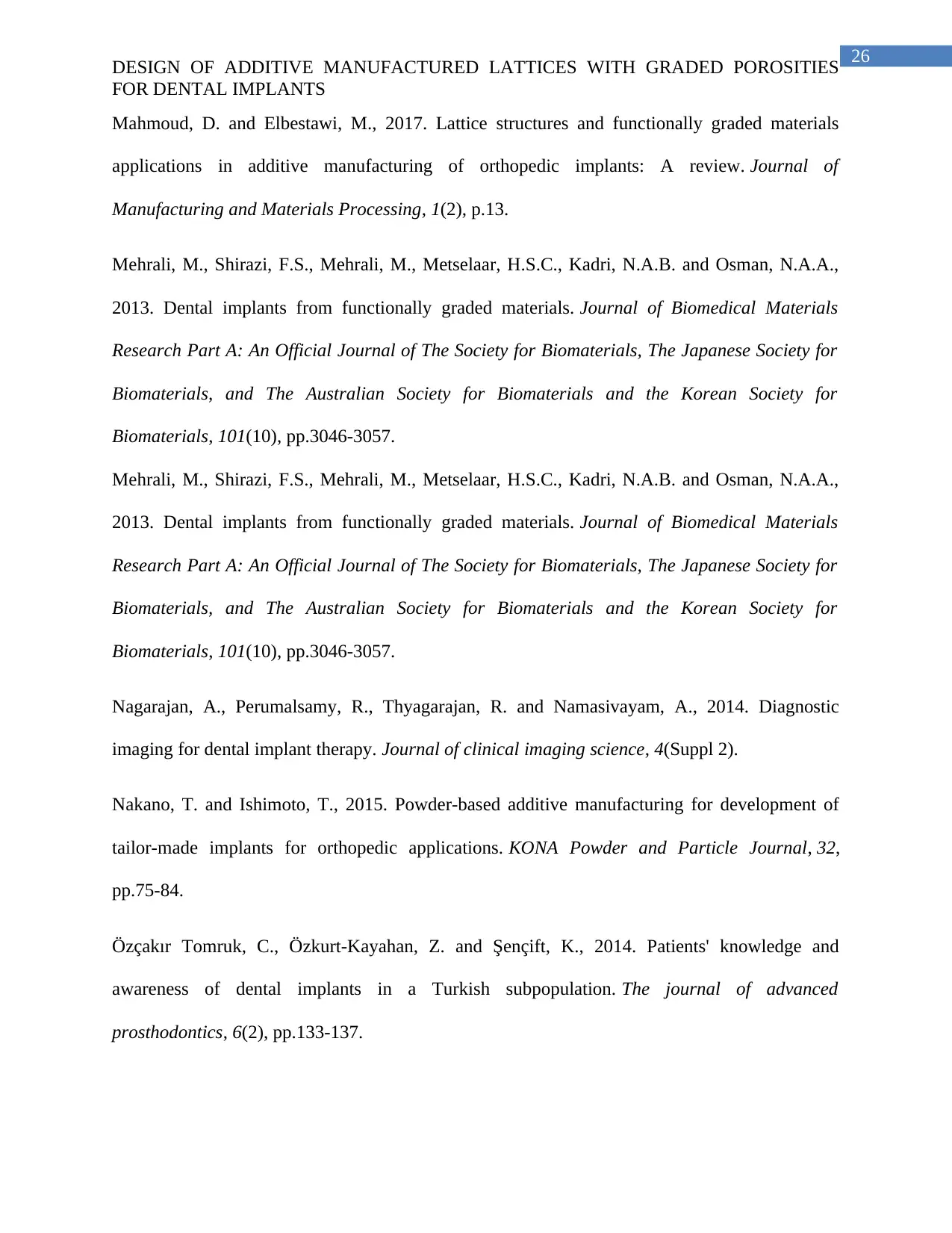
26
DESIGN OF ADDITIVE MANUFACTURED LATTICES WITH GRADED POROSITIES
FOR DENTAL IMPLANTS
Mahmoud, D. and Elbestawi, M., 2017. Lattice structures and functionally graded materials
applications in additive manufacturing of orthopedic implants: A review. Journal of
Manufacturing and Materials Processing, 1(2), p.13.
Mehrali, M., Shirazi, F.S., Mehrali, M., Metselaar, H.S.C., Kadri, N.A.B. and Osman, N.A.A.,
2013. Dental implants from functionally graded materials. Journal of Biomedical Materials
Research Part A: An Official Journal of The Society for Biomaterials, The Japanese Society for
Biomaterials, and The Australian Society for Biomaterials and the Korean Society for
Biomaterials, 101(10), pp.3046-3057.
Mehrali, M., Shirazi, F.S., Mehrali, M., Metselaar, H.S.C., Kadri, N.A.B. and Osman, N.A.A.,
2013. Dental implants from functionally graded materials. Journal of Biomedical Materials
Research Part A: An Official Journal of The Society for Biomaterials, The Japanese Society for
Biomaterials, and The Australian Society for Biomaterials and the Korean Society for
Biomaterials, 101(10), pp.3046-3057.
Nagarajan, A., Perumalsamy, R., Thyagarajan, R. and Namasivayam, A., 2014. Diagnostic
imaging for dental implant therapy. Journal of clinical imaging science, 4(Suppl 2).
Nakano, T. and Ishimoto, T., 2015. Powder-based additive manufacturing for development of
tailor-made implants for orthopedic applications. KONA Powder and Particle Journal, 32,
pp.75-84.
Özçakır Tomruk, C., Özkurt-Kayahan, Z. and Şençift, K., 2014. Patients' knowledge and
awareness of dental implants in a Turkish subpopulation. The journal of advanced
prosthodontics, 6(2), pp.133-137.
DESIGN OF ADDITIVE MANUFACTURED LATTICES WITH GRADED POROSITIES
FOR DENTAL IMPLANTS
Mahmoud, D. and Elbestawi, M., 2017. Lattice structures and functionally graded materials
applications in additive manufacturing of orthopedic implants: A review. Journal of
Manufacturing and Materials Processing, 1(2), p.13.
Mehrali, M., Shirazi, F.S., Mehrali, M., Metselaar, H.S.C., Kadri, N.A.B. and Osman, N.A.A.,
2013. Dental implants from functionally graded materials. Journal of Biomedical Materials
Research Part A: An Official Journal of The Society for Biomaterials, The Japanese Society for
Biomaterials, and The Australian Society for Biomaterials and the Korean Society for
Biomaterials, 101(10), pp.3046-3057.
Mehrali, M., Shirazi, F.S., Mehrali, M., Metselaar, H.S.C., Kadri, N.A.B. and Osman, N.A.A.,
2013. Dental implants from functionally graded materials. Journal of Biomedical Materials
Research Part A: An Official Journal of The Society for Biomaterials, The Japanese Society for
Biomaterials, and The Australian Society for Biomaterials and the Korean Society for
Biomaterials, 101(10), pp.3046-3057.
Nagarajan, A., Perumalsamy, R., Thyagarajan, R. and Namasivayam, A., 2014. Diagnostic
imaging for dental implant therapy. Journal of clinical imaging science, 4(Suppl 2).
Nakano, T. and Ishimoto, T., 2015. Powder-based additive manufacturing for development of
tailor-made implants for orthopedic applications. KONA Powder and Particle Journal, 32,
pp.75-84.
Özçakır Tomruk, C., Özkurt-Kayahan, Z. and Şençift, K., 2014. Patients' knowledge and
awareness of dental implants in a Turkish subpopulation. The journal of advanced
prosthodontics, 6(2), pp.133-137.
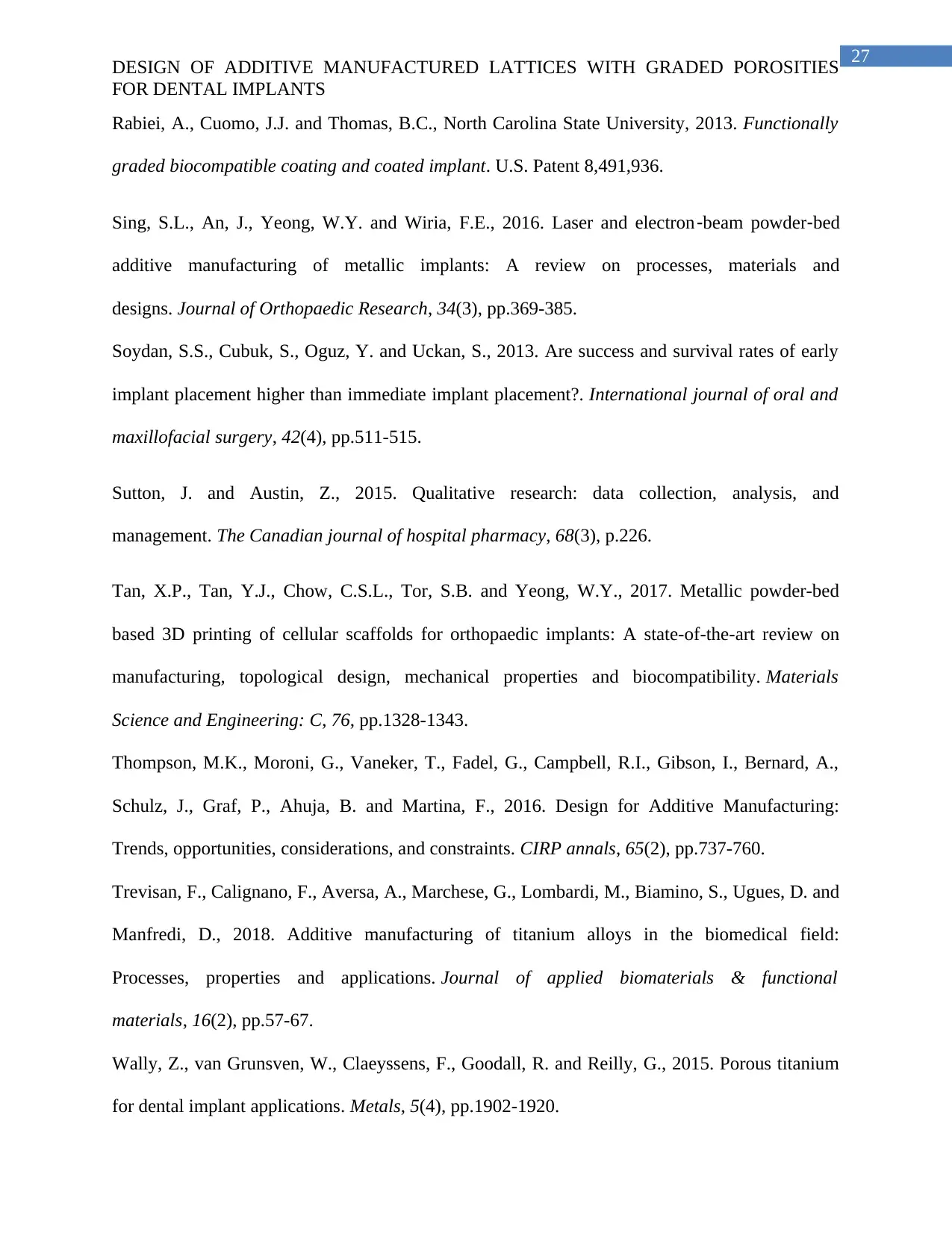
27
DESIGN OF ADDITIVE MANUFACTURED LATTICES WITH GRADED POROSITIES
FOR DENTAL IMPLANTS
Rabiei, A., Cuomo, J.J. and Thomas, B.C., North Carolina State University, 2013. Functionally
graded biocompatible coating and coated implant. U.S. Patent 8,491,936.
Sing, S.L., An, J., Yeong, W.Y. and Wiria, F.E., 2016. Laser and electron‐beam powder‐bed
additive manufacturing of metallic implants: A review on processes, materials and
designs. Journal of Orthopaedic Research, 34(3), pp.369-385.
Soydan, S.S., Cubuk, S., Oguz, Y. and Uckan, S., 2013. Are success and survival rates of early
implant placement higher than immediate implant placement?. International journal of oral and
maxillofacial surgery, 42(4), pp.511-515.
Sutton, J. and Austin, Z., 2015. Qualitative research: data collection, analysis, and
management. The Canadian journal of hospital pharmacy, 68(3), p.226.
Tan, X.P., Tan, Y.J., Chow, C.S.L., Tor, S.B. and Yeong, W.Y., 2017. Metallic powder-bed
based 3D printing of cellular scaffolds for orthopaedic implants: A state-of-the-art review on
manufacturing, topological design, mechanical properties and biocompatibility. Materials
Science and Engineering: C, 76, pp.1328-1343.
Thompson, M.K., Moroni, G., Vaneker, T., Fadel, G., Campbell, R.I., Gibson, I., Bernard, A.,
Schulz, J., Graf, P., Ahuja, B. and Martina, F., 2016. Design for Additive Manufacturing:
Trends, opportunities, considerations, and constraints. CIRP annals, 65(2), pp.737-760.
Trevisan, F., Calignano, F., Aversa, A., Marchese, G., Lombardi, M., Biamino, S., Ugues, D. and
Manfredi, D., 2018. Additive manufacturing of titanium alloys in the biomedical field:
Processes, properties and applications. Journal of applied biomaterials & functional
materials, 16(2), pp.57-67.
Wally, Z., van Grunsven, W., Claeyssens, F., Goodall, R. and Reilly, G., 2015. Porous titanium
for dental implant applications. Metals, 5(4), pp.1902-1920.
DESIGN OF ADDITIVE MANUFACTURED LATTICES WITH GRADED POROSITIES
FOR DENTAL IMPLANTS
Rabiei, A., Cuomo, J.J. and Thomas, B.C., North Carolina State University, 2013. Functionally
graded biocompatible coating and coated implant. U.S. Patent 8,491,936.
Sing, S.L., An, J., Yeong, W.Y. and Wiria, F.E., 2016. Laser and electron‐beam powder‐bed
additive manufacturing of metallic implants: A review on processes, materials and
designs. Journal of Orthopaedic Research, 34(3), pp.369-385.
Soydan, S.S., Cubuk, S., Oguz, Y. and Uckan, S., 2013. Are success and survival rates of early
implant placement higher than immediate implant placement?. International journal of oral and
maxillofacial surgery, 42(4), pp.511-515.
Sutton, J. and Austin, Z., 2015. Qualitative research: data collection, analysis, and
management. The Canadian journal of hospital pharmacy, 68(3), p.226.
Tan, X.P., Tan, Y.J., Chow, C.S.L., Tor, S.B. and Yeong, W.Y., 2017. Metallic powder-bed
based 3D printing of cellular scaffolds for orthopaedic implants: A state-of-the-art review on
manufacturing, topological design, mechanical properties and biocompatibility. Materials
Science and Engineering: C, 76, pp.1328-1343.
Thompson, M.K., Moroni, G., Vaneker, T., Fadel, G., Campbell, R.I., Gibson, I., Bernard, A.,
Schulz, J., Graf, P., Ahuja, B. and Martina, F., 2016. Design for Additive Manufacturing:
Trends, opportunities, considerations, and constraints. CIRP annals, 65(2), pp.737-760.
Trevisan, F., Calignano, F., Aversa, A., Marchese, G., Lombardi, M., Biamino, S., Ugues, D. and
Manfredi, D., 2018. Additive manufacturing of titanium alloys in the biomedical field:
Processes, properties and applications. Journal of applied biomaterials & functional
materials, 16(2), pp.57-67.
Wally, Z., van Grunsven, W., Claeyssens, F., Goodall, R. and Reilly, G., 2015. Porous titanium
for dental implant applications. Metals, 5(4), pp.1902-1920.
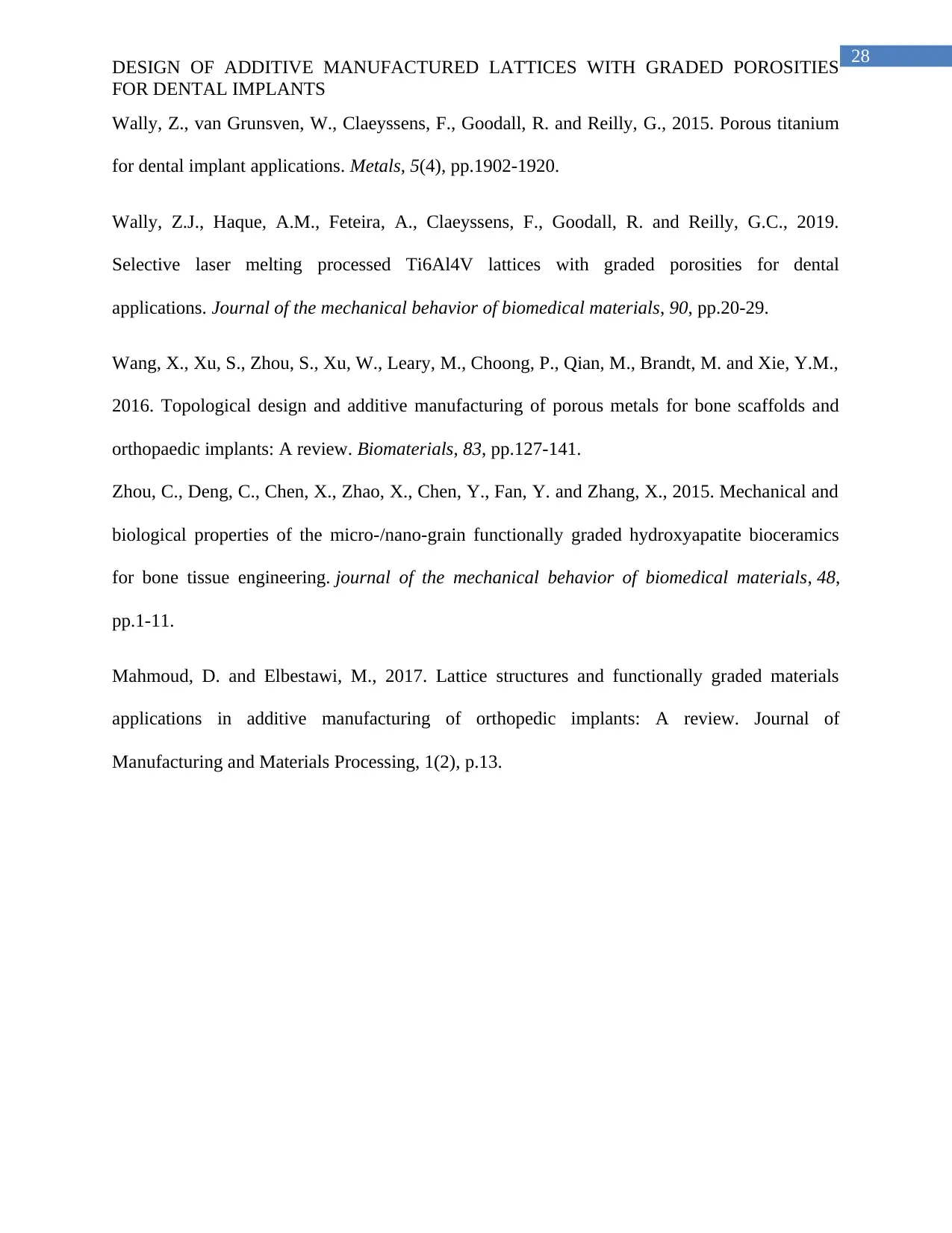
28
DESIGN OF ADDITIVE MANUFACTURED LATTICES WITH GRADED POROSITIES
FOR DENTAL IMPLANTS
Wally, Z., van Grunsven, W., Claeyssens, F., Goodall, R. and Reilly, G., 2015. Porous titanium
for dental implant applications. Metals, 5(4), pp.1902-1920.
Wally, Z.J., Haque, A.M., Feteira, A., Claeyssens, F., Goodall, R. and Reilly, G.C., 2019.
Selective laser melting processed Ti6Al4V lattices with graded porosities for dental
applications. Journal of the mechanical behavior of biomedical materials, 90, pp.20-29.
Wang, X., Xu, S., Zhou, S., Xu, W., Leary, M., Choong, P., Qian, M., Brandt, M. and Xie, Y.M.,
2016. Topological design and additive manufacturing of porous metals for bone scaffolds and
orthopaedic implants: A review. Biomaterials, 83, pp.127-141.
Zhou, C., Deng, C., Chen, X., Zhao, X., Chen, Y., Fan, Y. and Zhang, X., 2015. Mechanical and
biological properties of the micro-/nano-grain functionally graded hydroxyapatite bioceramics
for bone tissue engineering. journal of the mechanical behavior of biomedical materials, 48,
pp.1-11.
Mahmoud, D. and Elbestawi, M., 2017. Lattice structures and functionally graded materials
applications in additive manufacturing of orthopedic implants: A review. Journal of
Manufacturing and Materials Processing, 1(2), p.13.
DESIGN OF ADDITIVE MANUFACTURED LATTICES WITH GRADED POROSITIES
FOR DENTAL IMPLANTS
Wally, Z., van Grunsven, W., Claeyssens, F., Goodall, R. and Reilly, G., 2015. Porous titanium
for dental implant applications. Metals, 5(4), pp.1902-1920.
Wally, Z.J., Haque, A.M., Feteira, A., Claeyssens, F., Goodall, R. and Reilly, G.C., 2019.
Selective laser melting processed Ti6Al4V lattices with graded porosities for dental
applications. Journal of the mechanical behavior of biomedical materials, 90, pp.20-29.
Wang, X., Xu, S., Zhou, S., Xu, W., Leary, M., Choong, P., Qian, M., Brandt, M. and Xie, Y.M.,
2016. Topological design and additive manufacturing of porous metals for bone scaffolds and
orthopaedic implants: A review. Biomaterials, 83, pp.127-141.
Zhou, C., Deng, C., Chen, X., Zhao, X., Chen, Y., Fan, Y. and Zhang, X., 2015. Mechanical and
biological properties of the micro-/nano-grain functionally graded hydroxyapatite bioceramics
for bone tissue engineering. journal of the mechanical behavior of biomedical materials, 48,
pp.1-11.
Mahmoud, D. and Elbestawi, M., 2017. Lattice structures and functionally graded materials
applications in additive manufacturing of orthopedic implants: A review. Journal of
Manufacturing and Materials Processing, 1(2), p.13.
1 out of 28
Your All-in-One AI-Powered Toolkit for Academic Success.
+13062052269
info@desklib.com
Available 24*7 on WhatsApp / Email
![[object Object]](/_next/static/media/star-bottom.7253800d.svg)
Unlock your academic potential
© 2024 | Zucol Services PVT LTD | All rights reserved.


